





Reveiws/Accounts/Perspective
43)"Next-generation CO2 Electroreduction: the Role of Atomically Precise
Nanoclusters and Emerging Catalytic Strategies"
M. Ghosh, R. Sarma, M. Kamiyama, T. Kawawaki, S. Biswas,* Y. Negishi*
Nanoscale Horiz. 10, 1250-1267 (2025).
Invited Review to "the themed collection: Celebrating 10 Years of Materials Horizons: 10th Anniversary Collection "(Invited by Prof. Katharina Landfester,. Editorial Board Chair, Nanoscale Horizons)
Selected as "Outside Front Cover"
The electrochemical reduction of carbon dioxide (CO₂) is a promising approach
to simultaneously mitigate greenhouse gas emissions and produce value-added
carbon-based fuels and chemicals. However, sluggish reaction kinetics necessitate
the development of efficient catalysts to enhance activity and selectivity.
Metal nanoclusters (NCs) have emerged as highly promising candidates due
to their atomically precise structures, unique electronic properties, and
tunable catalytic behaviors Despite continuous advancements in the synthesis
and application of metal NCs, several challenges remain that hinder their
practical deployment. Stability, scalability, and the fine control of selectivity
remain critical concerns. This review systematically explores the stepwise
evolution of metal NCs as catalysts for CO₂ electroreduction, highlighting
their key advantages while also identifying the fundamental limitations
that need to be addressed. To overcome such challenges a key development
is observed leads to shift from noble-metal NCs to first-row transition-metal-based
NCs, which has expanded catalytic reactivity and product selectivity. Additionally,
the role of alloying in enhancing catalytic performance through synergistic
interactions and electronic modifications is discussed. So, this review
provides a comprehensive analysis of recent progress, with a focus on emerging
NC-based electrocatalyst, and outlines future directions to address existing
challenges for sustainable CO₂ conversion..
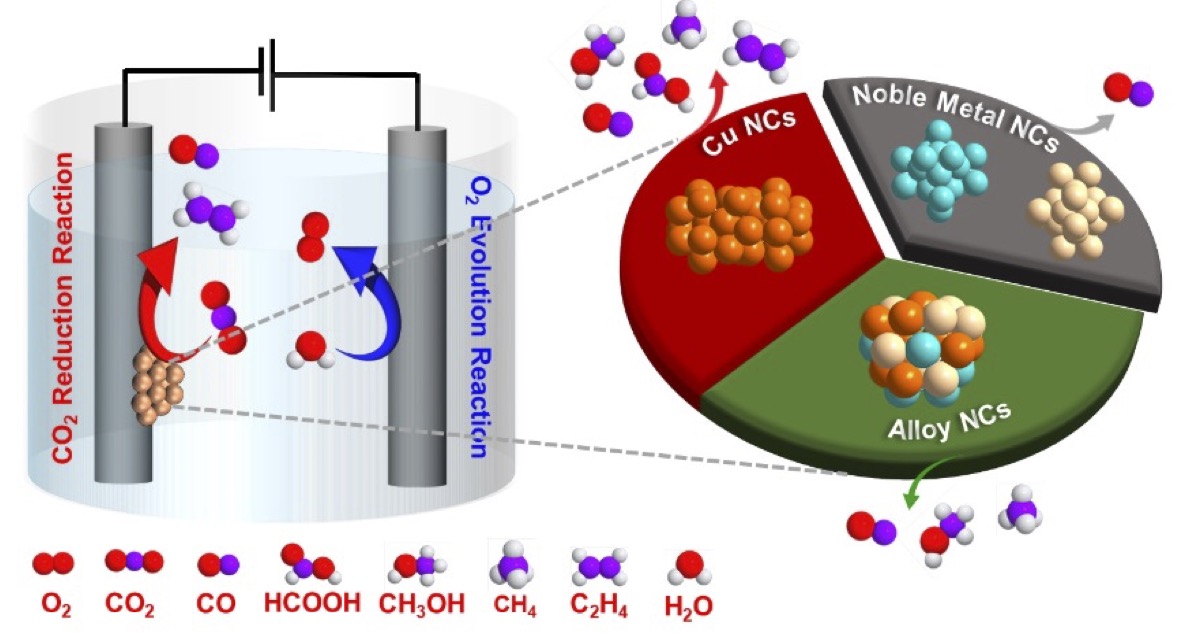
42)"Converging the complementary traits of MOFs and COFs"
R. Nakatani, T. Irie, S. Das,* Q. Fang,* Y. Negishi*
ACS Appl. Mater. Interfaces 17, 24701-24729 (2025).
Invited Review (Invited by Prof. Peter Müller-Buschbaum, Deputy Editor, ACS Applied Materials & Interfaces)
Selected as "Supplementary Cover"
Highlighted in "ACS ASIA INSIGHT-Japan"
Since their discovery, metal-organic frameworks (MOFs) and covalent organic
frameworks (COFs) featuring permanent nanopores have transformed the landscape
of porous materials, excelling as platforms for catalysis, gas separation,
and sensing thanks to their exceptional surface areas, adjustable pore
sizes, and modular functionality. However, MOFs, while versatile, face
stability challenges due to their coordination bonds, whereas COFs, though
robust, lack metal sites, limiting their catalytic activity, redox functionality,
and other metal-specific applications. To bridge these gaps, innovative
porous materials such as MCOFs, which incorporate metal ions into COF lattices;
covalent cluster frameworks, formed by assembling metal clusters into covalent
networks; and MOF-COF composites, which integrate the strengths of both
systems, have emerged. This review explores the synthesis and design principles
of these advanced materials, showcasing their applications and the unique
advantages conferred by their composite nature. It provides insights into
future directions and their potential to address key challenges in materials
science and beyond.
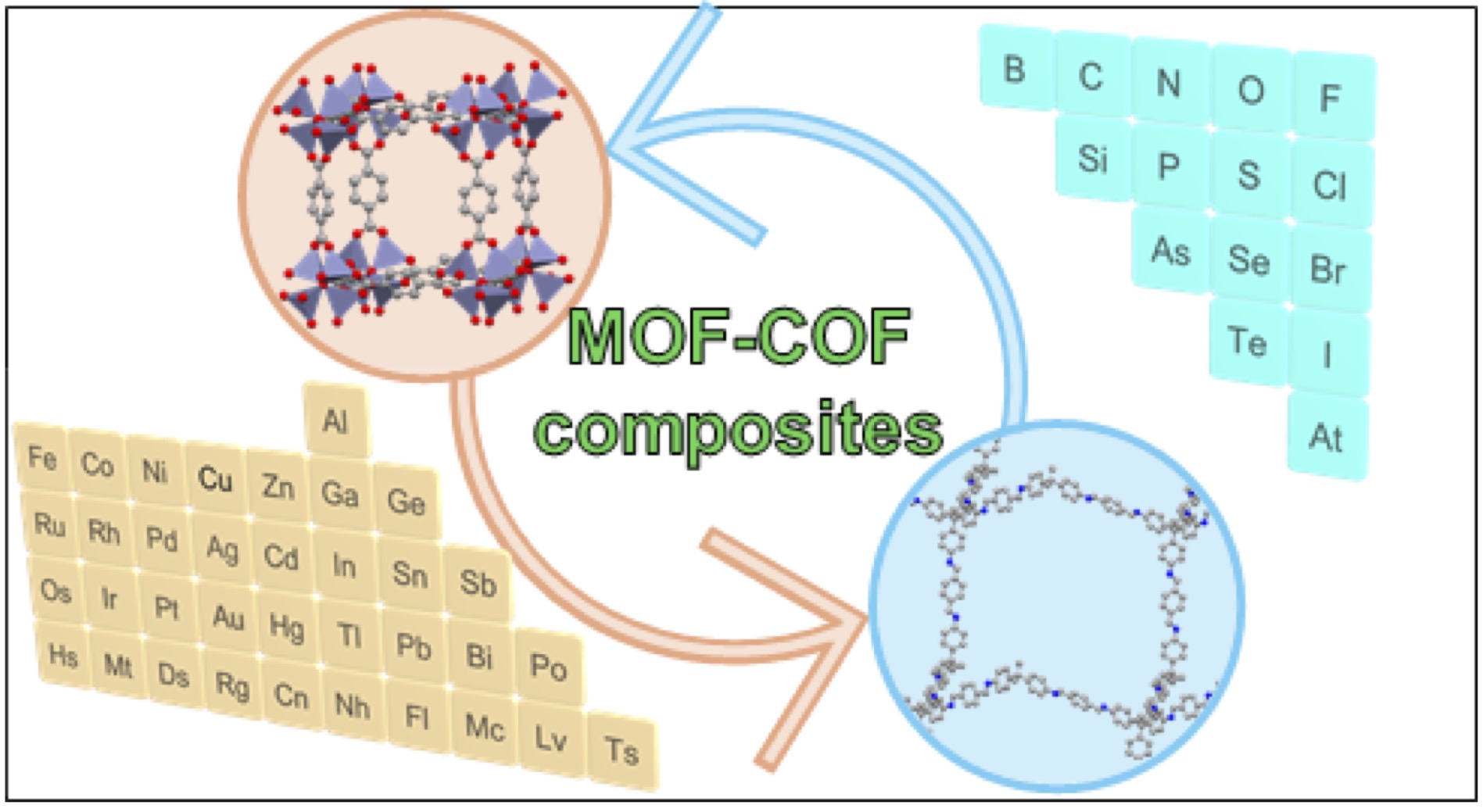
41)"The Importance and Discovery of Highly Connected Cova-lent Organic
Framework Net Topologies"
T. Irie, S. Das,* Q. Fang,* Y. Negishi*
J. Am. Chem. Soc. 147, 1367-1380 (2025).
Invited Perspective (Invited by Prof. Erick M. Carreira, Editor-in-Chief, Journal of the American Chemical Society)
Furthering the field of synthetic organic chemistry from the discrete molecules
regime to the extended structure regime, covalent organic frameworks (COFs)
represent a new genre of crystalline porous materials featuring designability
with molecular-level precision, well-defined porosity and exceptional stability
imparted by the robust covalent linkages reticulating organic molecules.
The topology of COFs is a principal feature that regulates their functionality
and usability for emerging technologies. Profound comprehension of network
topologies and maneuvering them towards targeted applications is crucial
to advancing the realm of COF research and developing novel functional
materials for exciting breakthroughs. In this Perspective, we discuss the
recent research pursuits contributing to the discovery of highly connected
COF nets having novel topologies, assess the key challenges to achieving
such network topologies, and offers insights into the current scenario
and future directions.
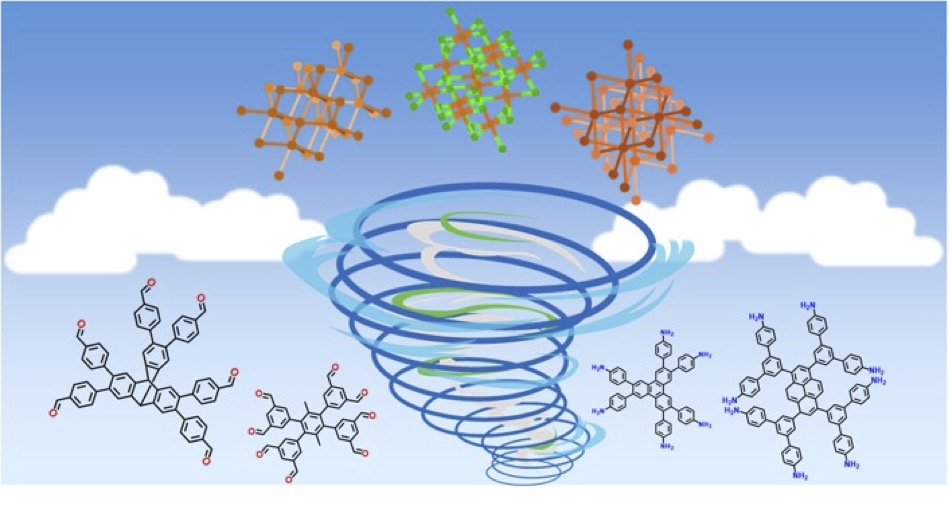
40)"Exploring the Structural Evolution of Cu–Thiolate Nanoclusters
and Their Property Correlations"
M. Kamiyama, Y. Shingyouchi, R. Sarma, M. Ghosh, T. Kawawaki, S. Biswas,*
Y. Negishi*
Chem. Commun. 61, 1048-1062 (2025).
Invited Feature Article (Invited Dr. Ershad Abubacker, Development Editor, Chem. Commun. etc)
Selected as "Inside Front Cover"
Research on copper nanoclusters (Cu NCs) is expanding rapidly due to their
remarkable structural versatility and related tunable properties they exhibit.
This fast-paced development creates a need for a comprehensive overview
of the structural evolution of Cu NCs, especially regarding how different
geometric configurations emerge from variations in the ligand choice. In
light of this, this feature article focuses on the role of thiolate ligands
in shaping the structural and electronic properties of Cu NCs, with a particular
emphasis on how modifications of ligands influence the geometry of NCs.
While thiolates play a central role in stabilizing Cu NCs, this feature
article also underscores the significance of co-ligands—such as hydrides,
phosphines, and halides—because relying solely on thiolates is often insufficient
to fully protect the surface of Cu NCs, unlike in the case of gold or silver
NCs. A detailed analysis of how various thiolates and co-ligands affect
core geometry reveals a direct correlation with the electronic properties
of Cu NCs, which in turn influences their optical behavior. By examining
these ligand-driven structural and electronic changes, this feature article
aims to provide a deeper understanding of the relationship between ligand
design and the resulting NC properties. The ultimate goal is to offer a
strategy for the rational design of Cu NCs with tailored functionalities,
thereby advancing NC chemistry and opening up new possibilities for applications
in optoelectronics, catalysis, and sensing.
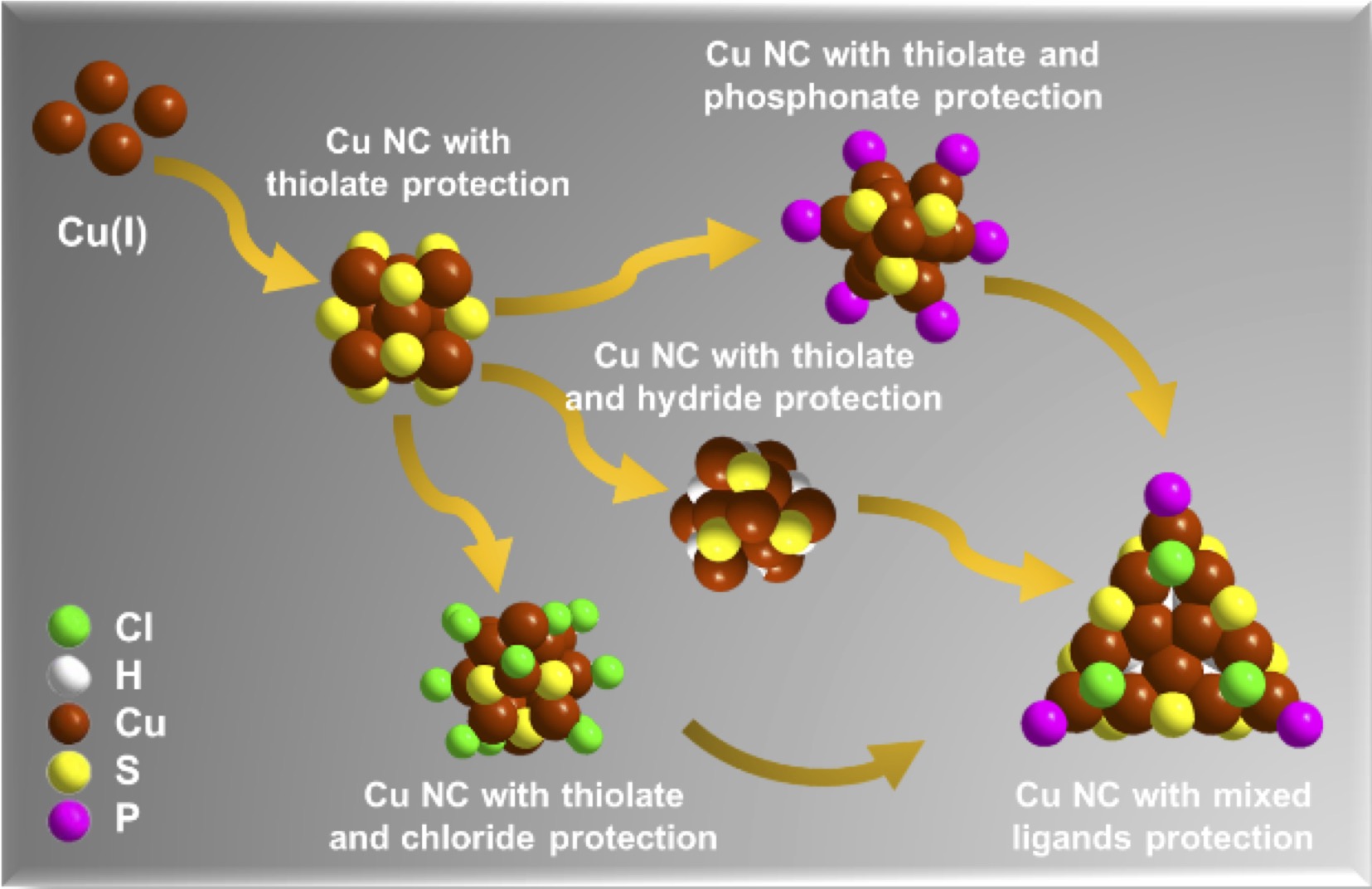
39)"Metal-Organic Frameworks as Promising Electrocatalysts for Nitrogen
Reduction Reaction: Mapping the Research Landscape and Identifying Future
Trends"
R. Nakatani, S. Das,* Y. Negishi*
J. Mater. Chem. A 12, 26350-26366 (2024).
Highlighted in "Themed collection: Journal of Materials Chemistry A Recent Review Articles"
Selected as "Back Cover"
Since the pioneering discovery of metal-organic frameworks (MOFs) a quarter
century ago, they have evolved as a new category of porous crystalline
extended network structures with atomic/molecular level designability.
Ever since this groundbreaking discovery, the distinctive porosity and
structural customizability attributes of MOFs have been instrumental to
a wide spectrum of applications. Especially among these applications, MOFs
rose to prominence as electrocatalysts in the nitrogen reduction reaction
(NRR) that has inimitable potential to solve environmental crises. The
reticular structures characterizing MOFs with uniformly distributed active
sites and their easy accessibility impart them with enhanced catalytic
activity. In this review, we provide a comprehensive overview of MOF-based
electrocatalysts hitherto adopted for NRR, besides giving an insight into
the future scopes and challenges.
.jpg)
38)"Navigating Challenges and Possibilities for Improving Polymer Electrolyte Membrane Fuel Cells via Pt Electrocatalyst, Support and Ionomer Advancements"
M. A. Haque, T. Kawawaki,* Y. Negishi*
Int. J. Hydrog. Energy, 85, 30-47 (2024).
Polymer electrolyte membrane fuel cells, which have already been put into
practical use in some areas, are expected to become widespread to realize
a next-generation sustainable energy society. However, it faces several
challenges to its performance and durability. The challenges include Pt
particle agglomeration, catalyst degradation, low Pt mass catalyst loading,
support material corrosion and mass transport resistance, which lead to
reduced catalytic activity, limited fuel cell efficiency and decreased
durability. Researchers have investigated multiple strategies to overcome
these challenges, such as catalyst alloying, support optimization, advanced
synthesis techniques, surface modification, and improved water and gas
management. This work focuses on the aforementioned challenges associated
with Pt nanocatalysts, catalyst supports, and ionomers in polymer electrolyte
fuel cells, offering a comprehensive review and discussion of these issues
and the corresponding mitigation approaches. In summation, it is suggested
that by addressing these challenges, we can pave the way for developing
more efficient, durable, and commercially viable fuel cell systems.
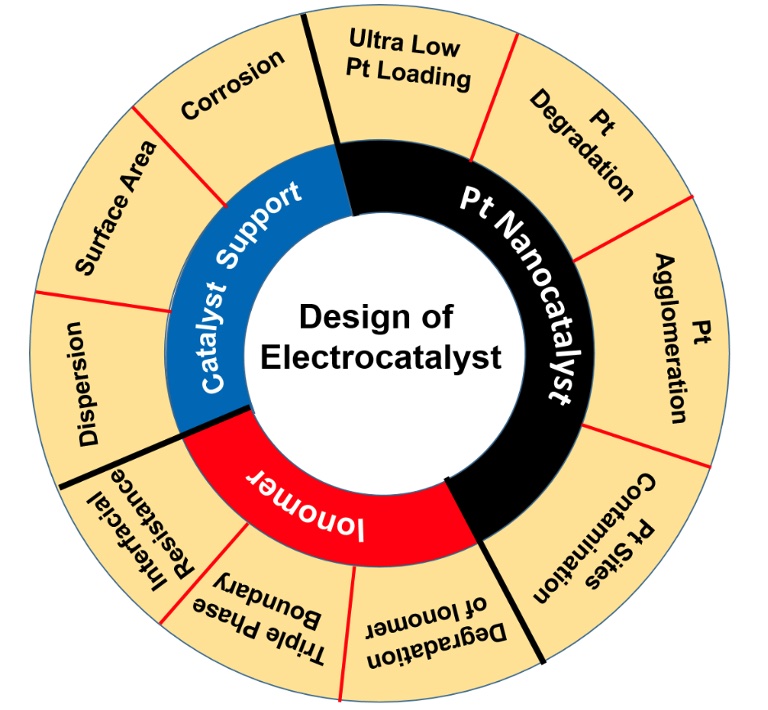
37)"Advancing Electrochemical CO2 Reduction with Group 11 Metal Nanoclusters
for Renewable Energy Solutions"
S. Biswas,* Y. Shingyouchi, M. Ogami, M. Kamiyama, T. Kawawaki, Y. Negishi*
EcoEnergy 2, 400-418 (2024).
Invited Review (Invited by Prof. Lianzhou Wang, Editor-in Chief, EcoEnegy)
Understanding the intricate relationship between structure and properties
is paramount in distinguishing nanocluster materials from their counterparts.
Despite the progress in synthesizing new nanoclusters, the sluggish exploration
of their potential applications persists due to the difficulty in stabilizing
these materials. However, recent investigations have unveiled their remarkable
efficacy as catalysts in electrochemical CO2 reduction reactions, surpassing
traditional materials. This discovery, addressing urgent global concerns,
has quickly drawn significant attention to this field, leading to its rapid
expansion. Hence, there is an urgent need to outline this research landscape
and pinpoint effective strategies, marking a significant advancement. In
this context, our endeavor is dedicated to offering researchers a thorough
understanding of recently synthesized NC materials. We aim to elucidate
their distinct structural architectures and associated properties essential
for catalyst design. We envision that this systematic review will serve
as a guiding beacon for future research endeavors in this burgeoning field.
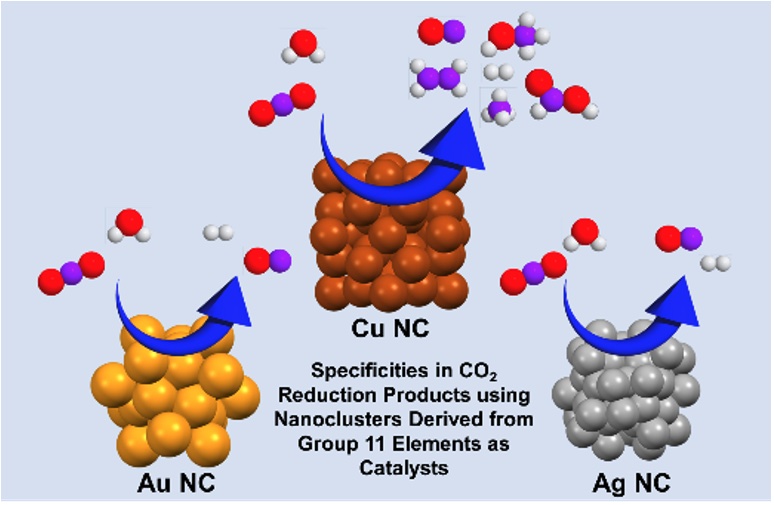
36)"Silver Cluster Assembled Materials: A Model-Driven Perspective
on Recent Progress, with a Spotlight on Ag12 Cluster Assembly"
S. Biswas, Y. Negishi*
Chem. Rec. 24, e202400052 (2024).
Selected as "Outside Front Cover"
The exploration of individual nanoclusters is rapidly advancing, despite stability concerns. To address this challenge, the assembly of cluster nodes through linker molecules has been successfully implemented. However, the linking of the cluster nodes itself introduces a multitude of possibilities, especially when additional factors come into play. While this method proves effective in enhancing material stability, the specific reasons behind its success remain elusive. In our laboratory, we have undertaken extensive studies on Ag cluster-assembled materials. So, here our goal is to establish a model system that allows for the discernment of various factors, eliminating unnecessary complexities during the linking approach. So, we hope that the systematic discourse presented in here will contribute significantly to future endeavors, helping to set clear priorities, and provide solutions to concerns that arise when working with a model system.
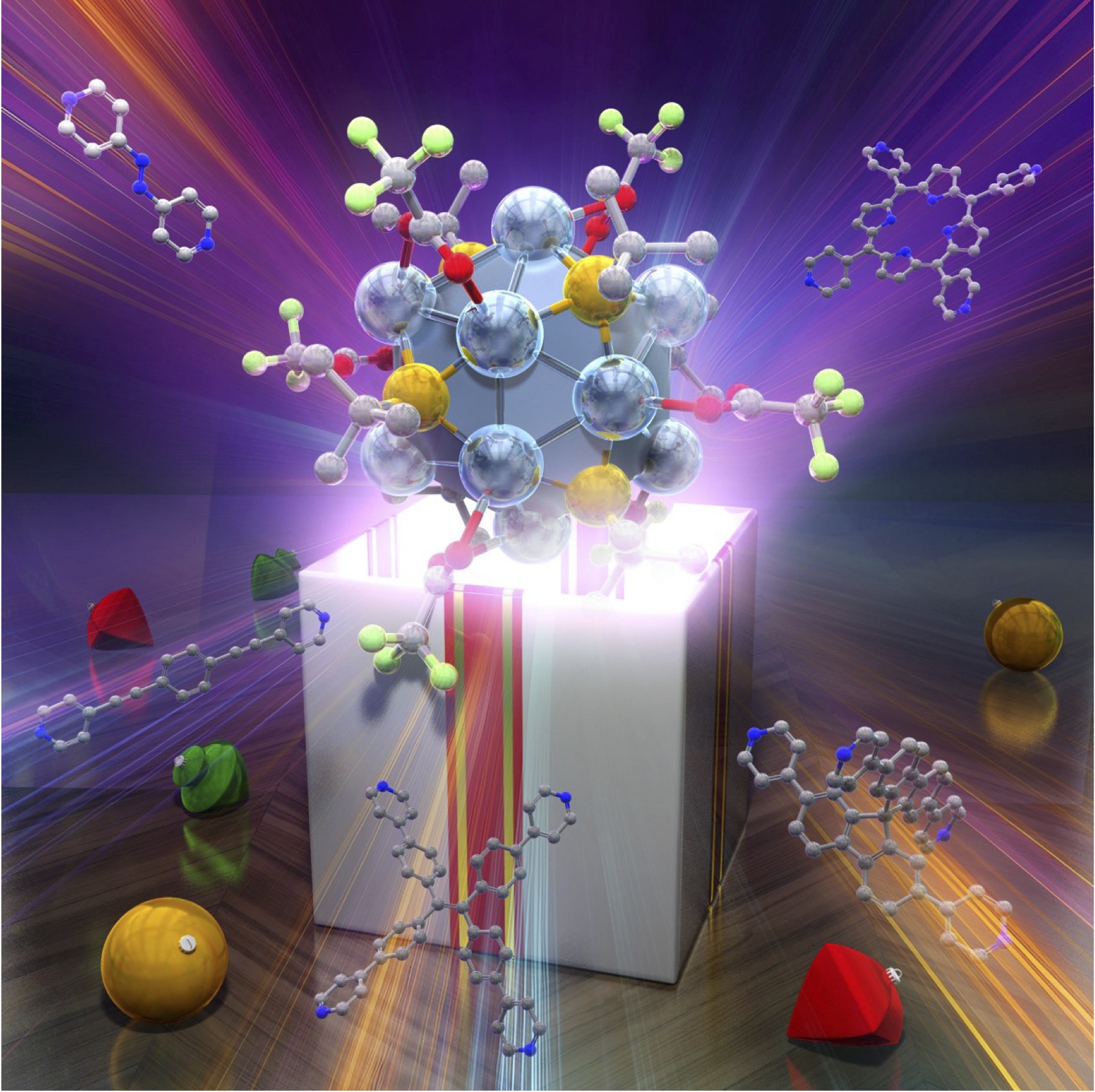
35)"Exploring the impact of various reducing agents on Cu nanocluster
synthesis"
S. Biswas, Y. Negishi*
Dalton Trans. 53, 9657-9663 (2024).
Invited "Frontier article" (Invited by Sally Howells-Wyllie, Editor, Dalton Transactions)
Selected as "Outside Front Cover"
The synthesis of copper (Cu) nanoclusters (NCs) has experienced significant advancements in recent years. Despite the exploration of metal NCs dating back almost two decades, challenges specific to Cu NC synthesis arise from the variable oxidation states and heightened reactivity of intermediate Cu complexes, distinguishing it from its analogous counterparts. In this study, we present a comprehensive overview of this newly evolving research domain, focusing on the synthetic aspects. We delve into various factors influencing the synthesis of Cu NCs, with specific emphasis on the role of reducing agents. The impact of the reducing agent is particularly pivotal in this synthetic process, ultimately influencing the formation of model M(0)-containing NCs, which are less readily accessible in the context of Cu NCs. We anticipate that this frontier article will pave the way for accelerated research in the field of Cu NCs. By aiding in the selection of specific reaction conditions and reducing agents, we believe that this work will contribute to a faster-paced exploration of Cu NCs, further advancing our understanding and applications in this exciting area of nanomaterial research.
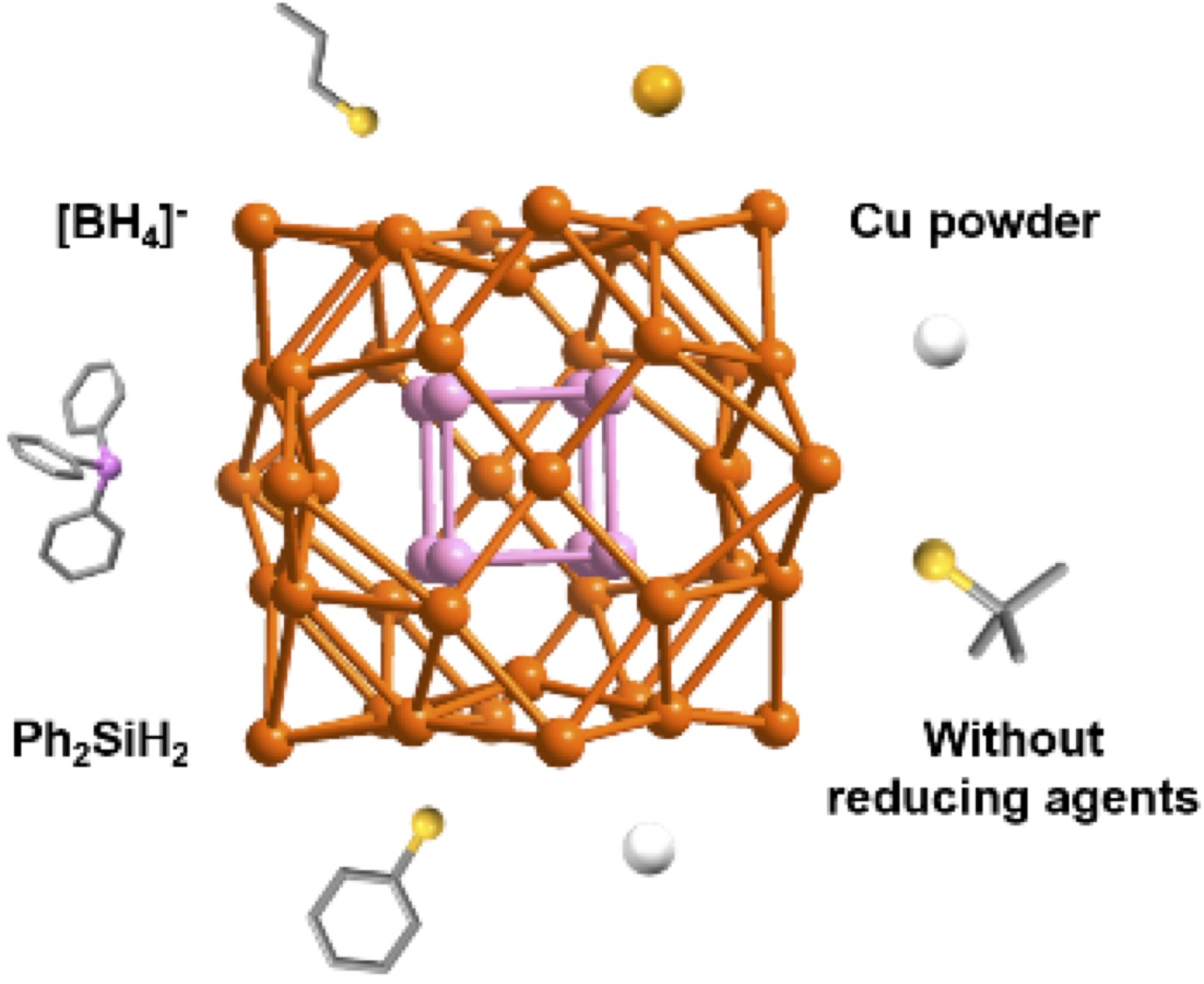
34)"Structure and Application Portfolio of Intricately Architected
Silver Cluster-Assembled Materials"
R. Nakatani, S. Das,* Y. Negishi*
Nanoscale 16, 9642-9658 (2024).
Invited "Review" (Invited by Edward Gardner, Development Editor)
Selected as "Outside Back Cover"
Highlighted in "Themed collection: Recent Review Articles"
Silver Cluster-Assembled Materials (SCAMs) represent a new frontier of
crystalline extended solids hallmarked by their customizable structures,
commendable stabilities, and unique physical/chemical properties. Since
their discovery in 2017, the diversity of organic linkers has afforded
the SCAMs with ingenious architectures and the application scenario has
expanded beyond photoluminescence sensing to environmental sustainability
and biomedical applications. It is critically important to chronicle these
recent key advances and review the progress of SCAMs that can enable translating
the material discoveries into real implementation. Herein, we provide a
succinct overview of the trajectory of SCAM research, with crucial insights
into atomic-level structural correlations with the phenomena at the nanoscale,
and discuss the gaps and opportunities that are still open in addition
to charting a roadmap for future research directions.
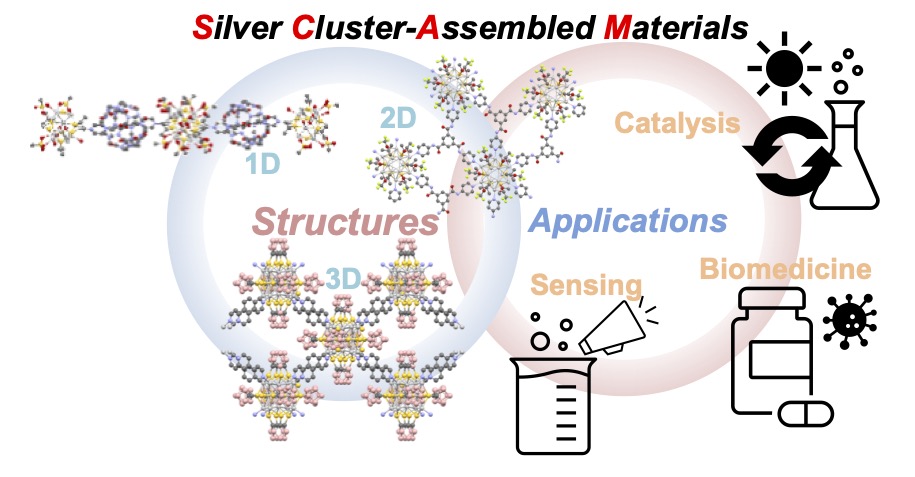
33)"Triplet-Triplet Annihilation-Based Photon Upconversion Using Nanoparticles
and Nanoclusters"
Y. Niihori,* T, Kosaka, Y. Negishi*
Mater. Horiz. 11, 2304-2322 (2024)
Selected as "Inside Front Cover"
Highligted in "Themed Collection: Recent Review Articles"
The phenomenon of photon upconversion (UC), generating high-energy photons
from low-energy photons, has attracted significant attention. In particular,
triplet-triplet annihilation-based UC (TTA-UC) has been achieved by combining
the excitation states of two types of molecules, called the sensitizer
and emitter (or annihilator). With TTA-UC, it is possible to convert weak,
incoherent near-infrared (NIR) light, which constitutes half of the solar
radiation intensity, into ultraviolet and visible light that are suitable
for the operation of light-responsive functional materials or devices such
as solar cells and photocatalysts. Research on TTA-UC is being conducted
worldwide, often employing materials with high intersystem crossing rates,
such as metal porphyrins, as sensitizers. This review summarizes recent
research and trends in triplet energy transfer and TTA-UC for semiconductor
nanoparticles or nanocrystals with diameters in the nanometer range, also
known as quantum dots, and for ligand-protected metal nanoclusters, which
have even smaller well-defined sub-nanostructures. Concerning nanoparticles,
transmitter ligands have been applied on the surface of the nanoparticles
to efficiently transfer triplet excitons formed inside the nanoparticles
to emitters. Applications are expanding to solid-state UC devices that
convert NIR light to visible light. Additionally, there is active research
in the development of sensitizers using more cost-effective and environmentally
friendly elements. Regarding metal nanoclusters, methods have been established
for the evaluation of excited states, deepening the understanding of luminescent
properties and excited relaxation processes.
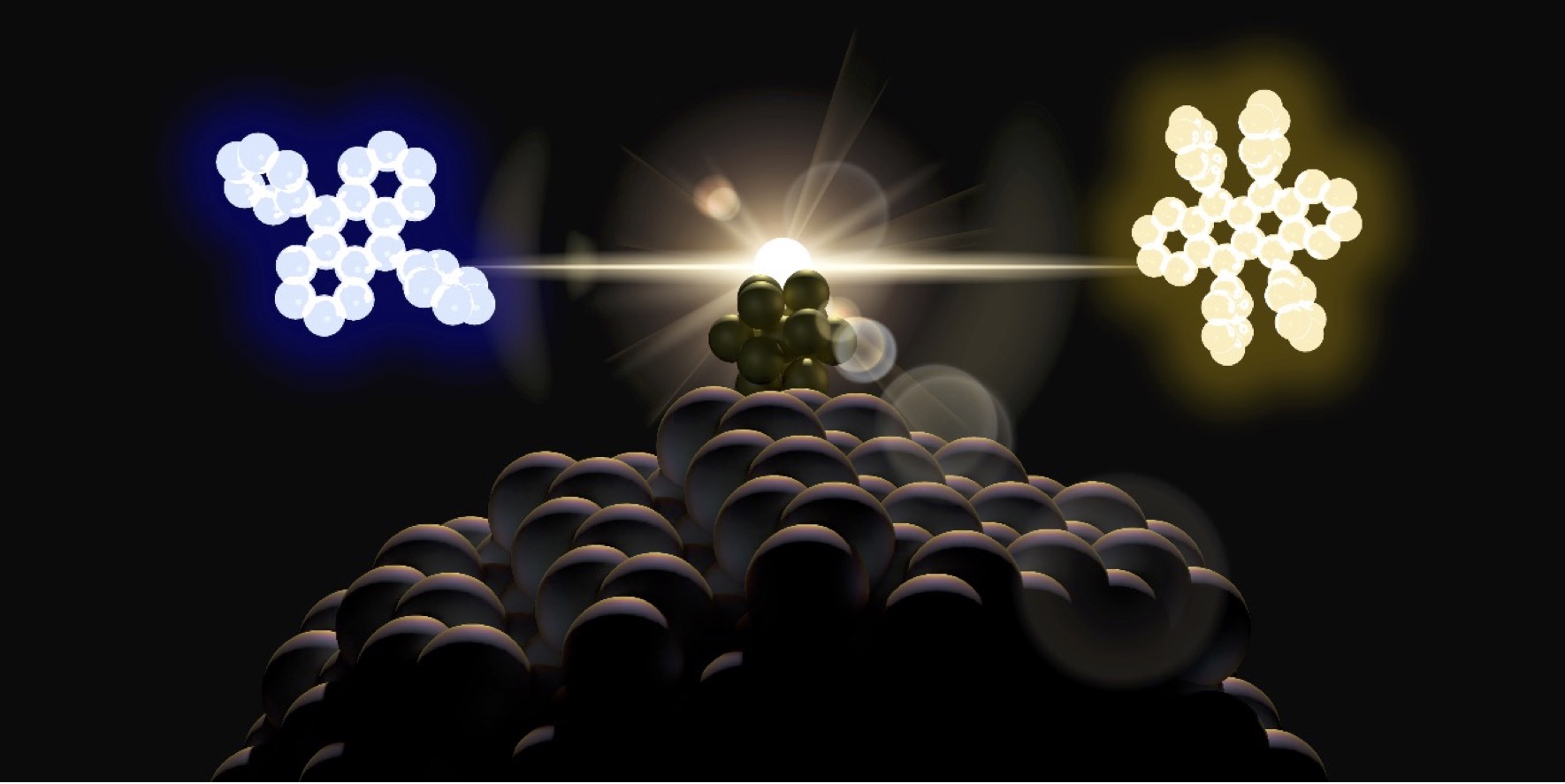
32)"Size-Dependent Carbon Dioxide Reduction Activity of Copper Nanoparticle
and Nanocluster Electrocatalysts"
T. Kawawaki,* T. Okada, K. Takemae, S. Tomihari, Y. Negishi*
ChemNanoMat in press.
Invited Review to Special Collection "Early Career Researchers 2023"
(Invited by Dr. Claire M. Cobley, Editor-in-Chief)
Selected as "Hot Topic: Carbon Dioxide"
The electrochemical carbon dioxide (CO2) reduction reaction (CRR, which
can convert CO2 into useful compounds at room temperature and ambient pressure
by using electricity derived from renewable energy source), has been attracting
attention in recent years. This is because it can convert CO2 into useful
compounds, which is pertinent to establishing a next-generation recycling-oriented
energy society. However, further improvement of the electrocatalyst is
required to improve its activity, selectivity, and durability. Among these,
copper (Cu) can synthesize various hydrocarbons from CO2 and has been the
most studied electrocatalyst for the CRR over many years. In particular,
regarding ligand-protected Cu particles for the CRR, the size, shape, and
ligands of Cu particles prepared by chemical reduction can be precisely
controlled. In this review, we summarize previous research on the size-dependence
of the CRR by using ligand-protected Cu particles (nanoparticles and nanoclusters)
prepared by liquid-phase reduction, and discuss the current status of these
studies for researchers on the electrochemical CRR.
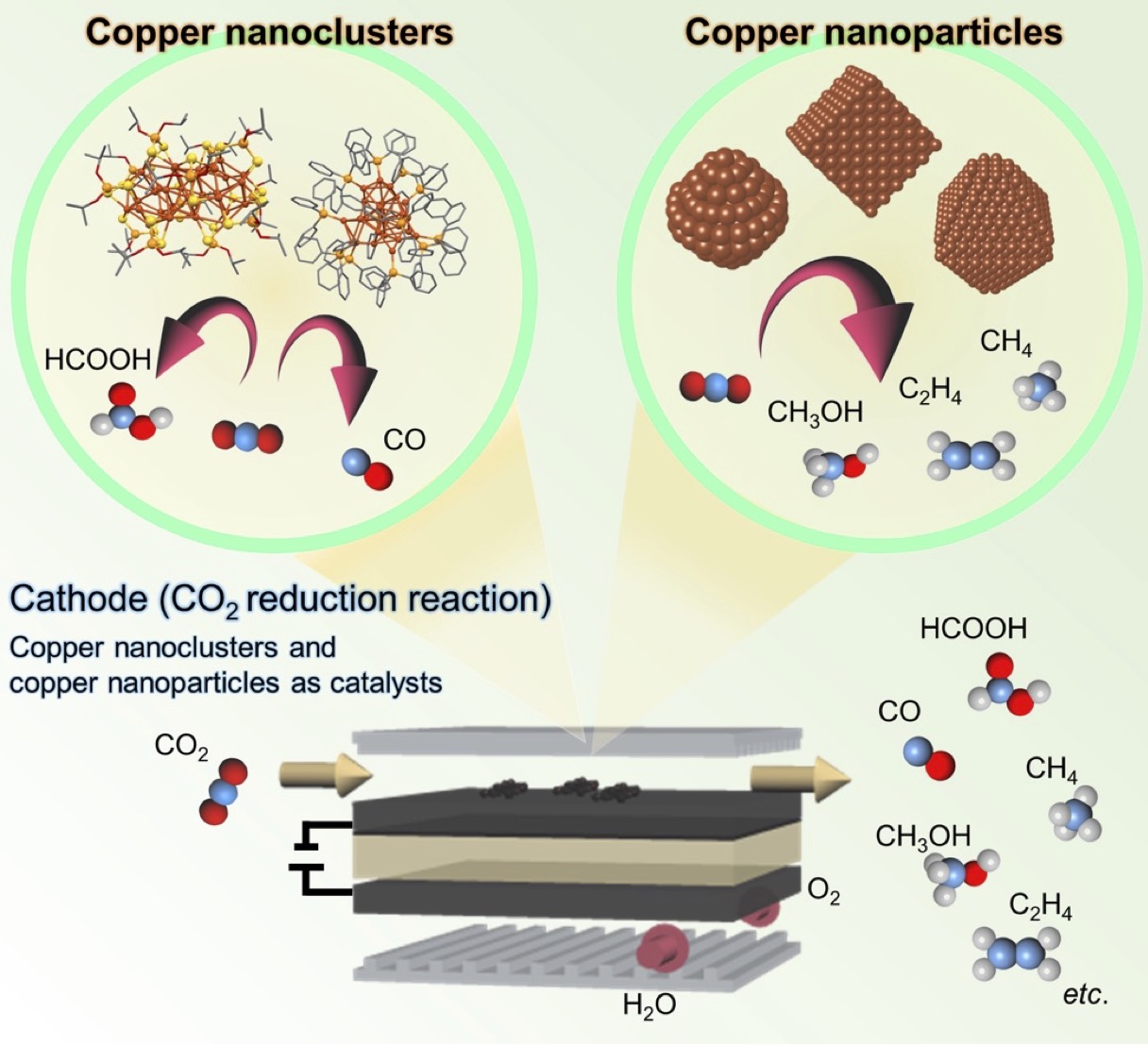
31)"A Comprehensive Analysis of Luminescent Crystalized Cu Nanoclusters"
S. Biswas, Y. Negishi*
J. Phys. Chem. Lett. 15, 947-958 (2024)
Invited Perspective (Invited by Prof. Gregory Scholes, Editor-in-Chief)
Selected as "Supplementary Cover"
Photoluminescence (PL) emission is an intriguing characteristic displayed
by atomically precise d10 metal nanoclusters (NCs), renowned for their
meticulous atomic arrangements that have captivated the scientific community.
Cu(I) NCs are a focal point in extensive research due to their abundance,
cost-effectiveness, and unique luminescent attributes. Despite similar
core sizes, their luminescent characteristics vary, influenced by multiple
factors. Progress hinges on synthesizing new NCs and modifying existing
ones, with post-synthetic alterations impacting emission properties. The
rapid advancements in this field pose challenges in discerning essential
points for excelling amidst competition with other d10 NCs. This perspective
article explores the intricate origins of PL emission in Cu(I) NCs, providing
a comprehensive review of their correlated structural architectures. Understanding
the mechanistic origin of PL emission in each cluster is crucial for correlating
diverse characteristics, contributing to a deeper comprehension from both
fundamental and applied scientific perspectives.
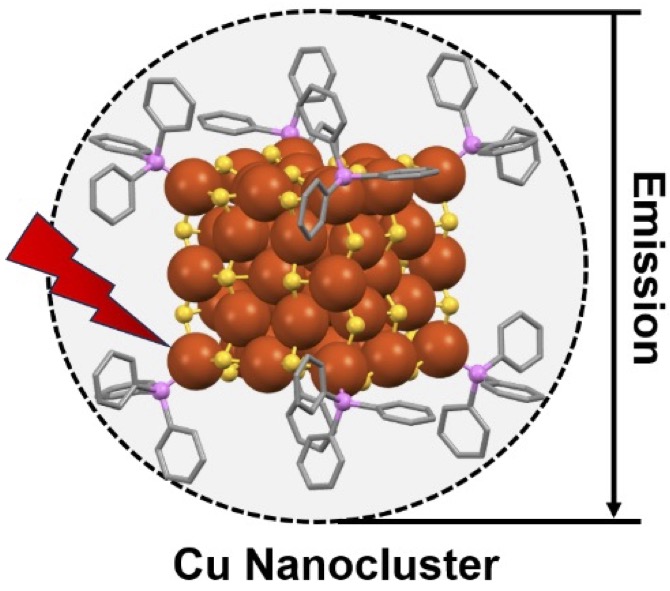
30)"Covalent Organic Frameworks: Cutting-Edge Materials for Carbon
Dioxide Capture and Water Harvesting from Air"
H. Mabuchi, T. Irie, J. Sakai, S. Das,* Y. Negishi*
Chem. Euro. J. 30, e202303474 (2024).
Invited Review to special collection "Covalent Organic Frameworks:
Green Synthesis and Cutting-Edge Applications"
Selected as "Inside Front Cover"
Selected as "Hot Topic: Carbon Dioxide"
The implacable rise of carbon dioxide (CO2) concentration in the atmosphere
and acute water stress are one of the central challenges of our time. Present-day
chemistry is strongly inclined towards more sustainable solutions. Covalent
organic frameworks (COFs), attributable to their structural designability
with atomic precision, functionalizable chemical environment and robust
extended architectures, have demonstrated promising performances in CO2
trapping and water harvesting from air. In this Review, we discuss the
major developments in this field as well as sketch out the opportunities
and shortcomings that remain over large-scale COF synthesis, device engineering,
and long-term performance in real environments.
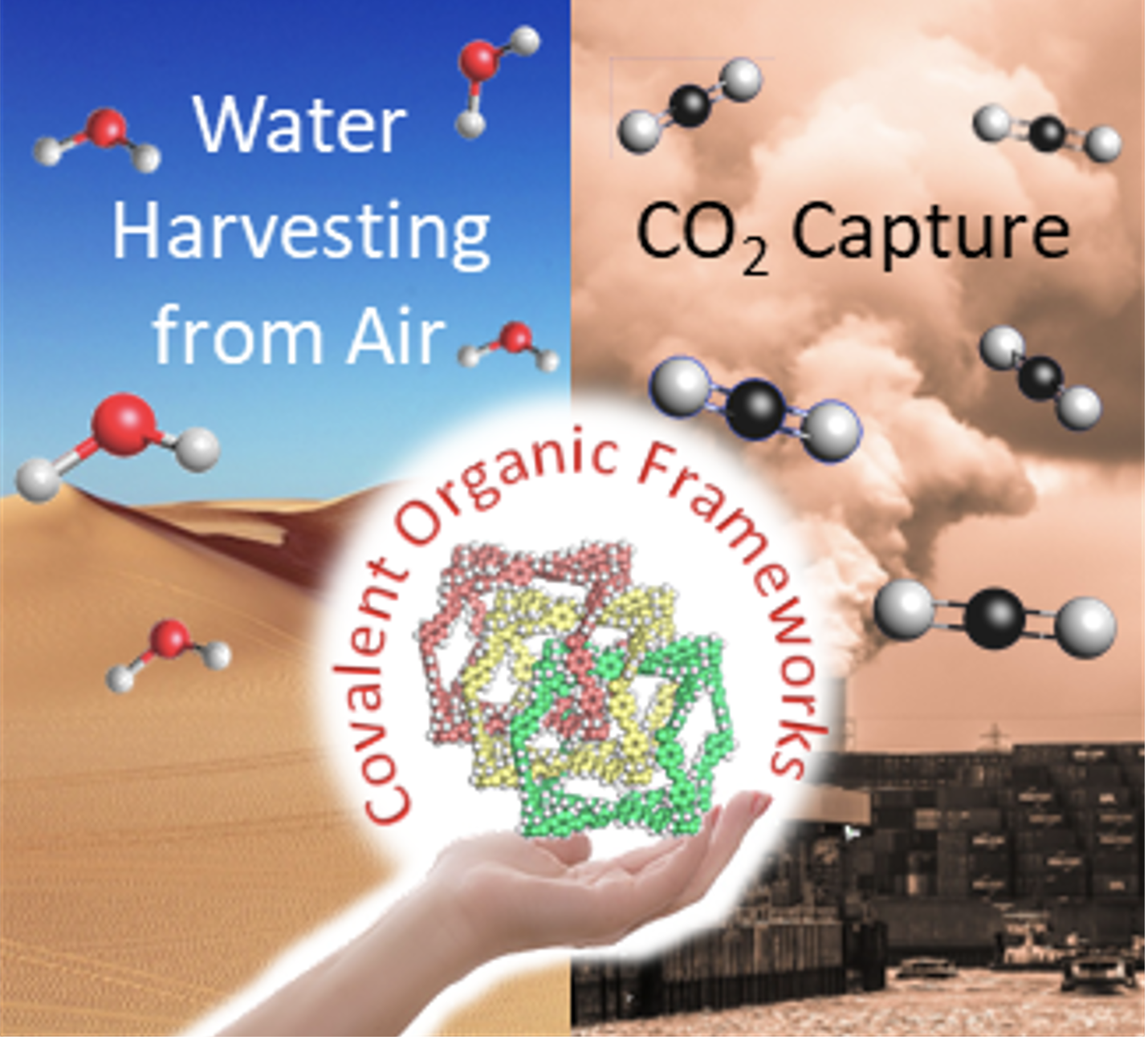
29)"Atomically Precise Metal Nanoclusters as Catalysts for Electrocatalytic
CO2 Reduction"
T. Kawawaki,* T. Okada, D. Hirayama, Y. Negishi*
Green Chem. 26, 122-163 (2024).
Invited Review to "Advances in Electrosynthesis for a Greener Chemical Industry"
Selected as "Outside Back Cover"
Electrochemical carbon dioxide (CO2) reduction can be used to convert CO2
into various compounds at room temperature and ambient pressure using electricity
generated from renewable energy sources. This technology is indispensable
in establishing an environmentally responsible and sustainable society.
However, further improvements in the activity and selectivity require the
development of electrocatalysts that can directly serve as the actual reaction
sites. In recent years, metal nanoclusters, which are metal particles with
a size of approximately 1 nm, have been reported to be capable of electrochemical
CO2 reduction with high activity and selectivity, owing to their unique
geometric/electronic structure. This review summarizes the synthesis methods
of atomically precise metal nanoclusters and their application in electrochemical
CO2 reduction. We expect that this review will help clarify the current
status of these studies and further accelerate the research on highly active
and selective CO2 reduction catalysts using metal nanoclusters.
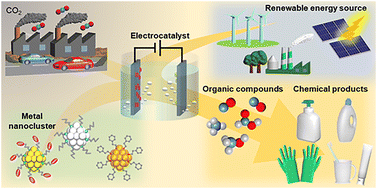
28)"Elucidation of the Electronic Structures of Thiolate-Protected Gold Nanoclusters
by Electrochemical Measurements"
T. Kawawaki,* Y. Negishi*
Dalton Trans. 52, 15152-15167 (2023).
Invited Review to "The New Talent: Asia-Pacific themed issue" (Invited by Associate editor, Prof. Takashi Uemura)
Selected as "Inside Front Cover"
Selected as "Dalton Transactions HOT Articles"
Selected as "2023 Frontier and Perspective articles"
Metal nanoclusters (NCs) with sizes of approximately 2 nm or less have
different physical/chemical properties from those of the bulk metals owing
to quantum size effects. Metal NCs, which can be size-controlled and heterometal
doped at atomic accuracy, are expected to be the next generation of important
materials, and new metal NCs are reported regularly. However, compared
with conventional materials such as metal complexes and relatively large
metal nanoparticles (>2 nm), these metal NCs are still underdeveloped
in terms of evaluation and establishment of application methods. Electrochemical
measurements are one of the most widely used methods for synthesis, application,
and characterisation of metal NCs. This review summarizes the basic knowledge
of the electrochemistry and experimental techniques, and provides examples
of the reported electronic states of thiolate-protected gold NCs elucidated
by electrochemical approaches. It is expected that this review will provide
useful information for researchers starting to study metal NCs.
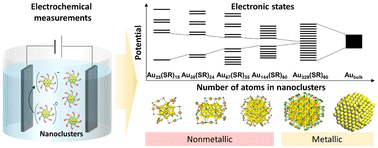
27)"Advances in Cu Nanocluster Catalyst Design: Recent Progress and
Promising Applications"
S. Biswas, S. Das,* Y. Negishi*
Nanoscale Horiz. 8, 1509-1522 (2023).
Selected as "Inside Front Cover"
Selected as "Nanoscale Horizons Most Popular 2023 Articles"
Selected as "Nanoscale Horizons HOT Papers"
Selected as "Themed collection Nanoscale Horizons Highly Cited Articles"
The quest for cleaner pathways to the production of fuels and chemicals
from non-fossil feedstock, efficient transformation of raw materials to
value-added chemicals under mild conditions, and control over the activity
and selectivity of chemical processes are driving the state-of-the-art
approaches to the construction and precise chemical modification of sustainable
nanocatalysts. As a burgeoning category of atomically precise noble metal
nanoclusters, copper nanoclusters (Cu NCs) benefitting from their exclusive
structural architecture, ingenious designability of active sites and high
surface-to-volume ratio qualify as potential rationally-designed catalysts.
In this Minireview, we present a detailed coverage of the optimal design
strategies and controlled synthesis of Cu NC catalysts with a focus on
tuning of active sites at the atomic level, the implications of cluster
size, shape and structure, the ligands and heteroatom doping on catalytic
activity, and reaction scope ranging from chemical catalysis to emerging
photocatalysis and electrocatalysis.
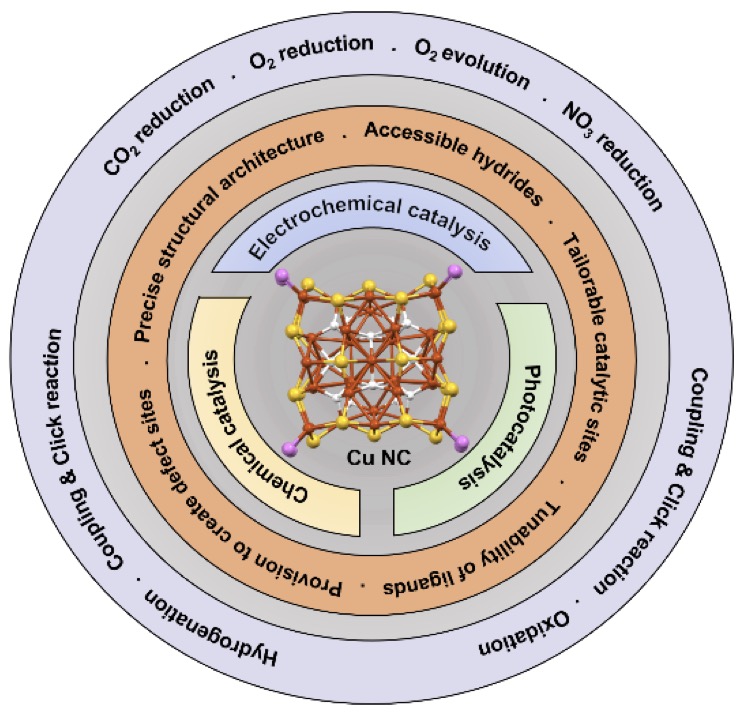
26)"Progress and Prospects in the Design of Functional Atomically-precise
Ag(I)-thiolate Nanoclusters and Their Assembly Approaches"
S. Biswas, S. Das, Y. Negishi*
Coord. Chem. Rev. 492, 215255 (2023).
Atomically-precise noble metal nanoclusters have raised nanomaterials research
to new heights by merit of their distinct structural, optical and electronic
properties, which can be leveraged for wide-ranging applications. The photoluminescence
characteristics has given greater prominence to thiolate-protected silver
nanoclusters (Ag NCs) for sensing, bioimaging and photovoltaics. Notwithstanding
high potential, the susceptibility to oxidation has left Ag NCs with limited
applicability. Reticular chemistry providing a platform for the transformation
of discrete entities to extended structures, Ag NCs could be linked with
organic struts via strong coordination bonds to form periodic networks
called silver cluster-assembled materials (SCAMs) that revealed abundant
catalytically active sites and unprecedented architectural stability. This
Review highlights the recent developments in the synthesis of Ag(I)-thiolate
NCs with special emphasis on size control, stability and optical properties,
besides discussing the synergistic interactions between Ag NCs and organic
linkers in coordination-assembled SCAMs facilitating the activity as well
as morphology evolution from supramolecular self-assembly of Ag NCs. Finally,
we provide an outlook of the challenges and opportunities covering from
fundamentals to functional devices and applications.
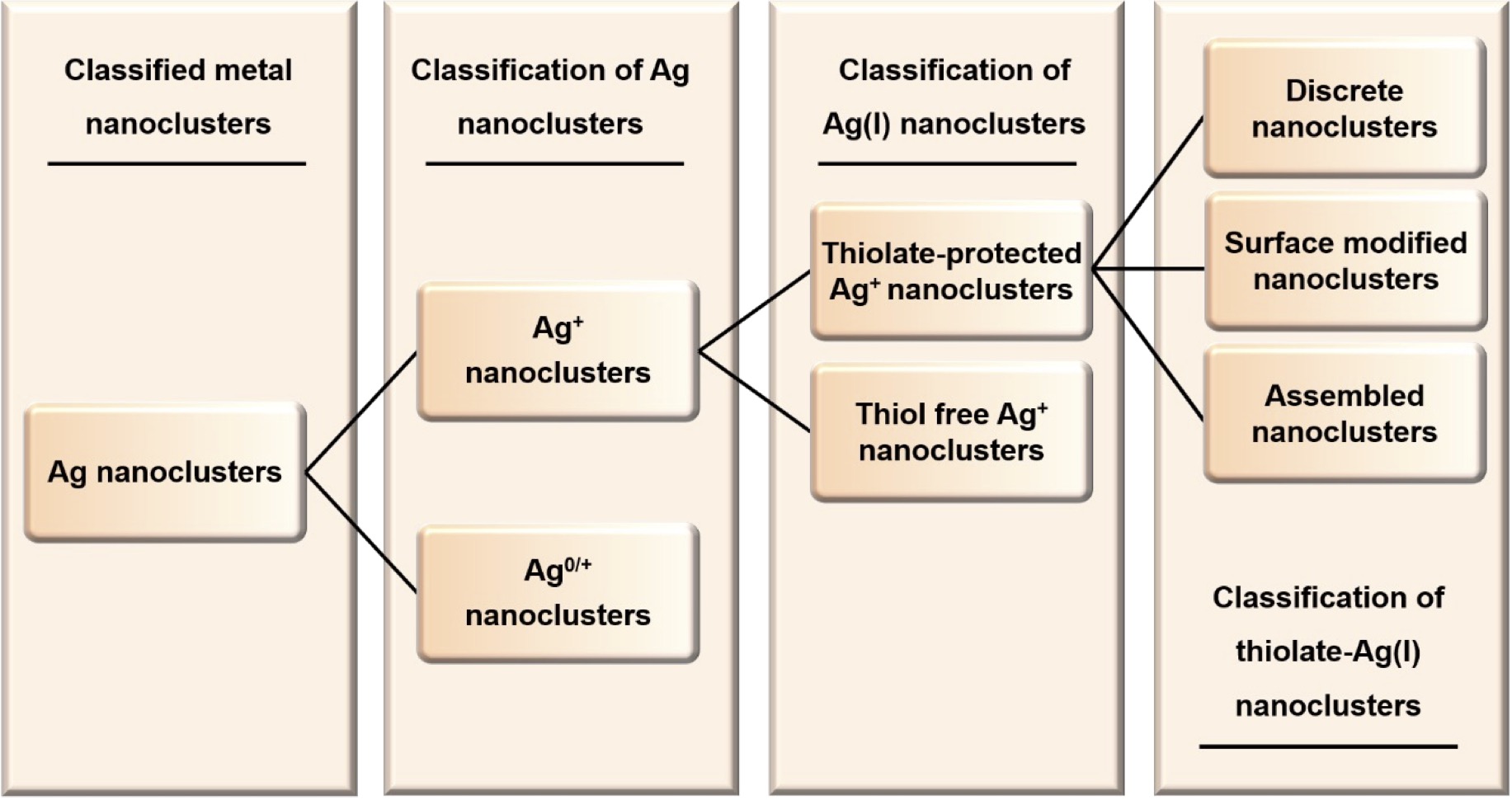
25)"Anion-templated Silver Nanoclusters: Precise Synthesis and Geometric
Structure"
Y. Horita, M. Ishimi, Y. Negishi*
Sci. Technol. Adv. Mater. 24, 2203832 (2023).
Invited Review to "Special Issue"
Metal nanoclusters (NCs) are gaining much attention in nanoscale materials
research because they exhibit size-specific physicochemical properties
that are not observed in the corresponding bulk metals. Among them, silver
(Ag) NCs can be precisely synthesized not only as pure Ag NCs but also
as anion-templated Ag NCs. For anion-templated Ag NCs, we can expect the
following capabilities: 1) size and shape control by regulating the central
anion (anion template); 2) stabilization by adjusting the charge interaction
between the central anion and surrounding Ag atoms; and 3) functionalization
by selecting the type of central anion. In this review, we summarize the
synthesis methods and influences of the central anion on the geometric
structure of anion-templated Ag NCs, which include halide ions, chalcogenide
ions, oxoanions, polyoxometalate, or hydride/deuteride as the central anion.
This summary provides a reference for the current state of anion-templated
Ag NCs, which may promote the development of anion-templated Ag NCs with
novel geometric structures and physicochemical properties.
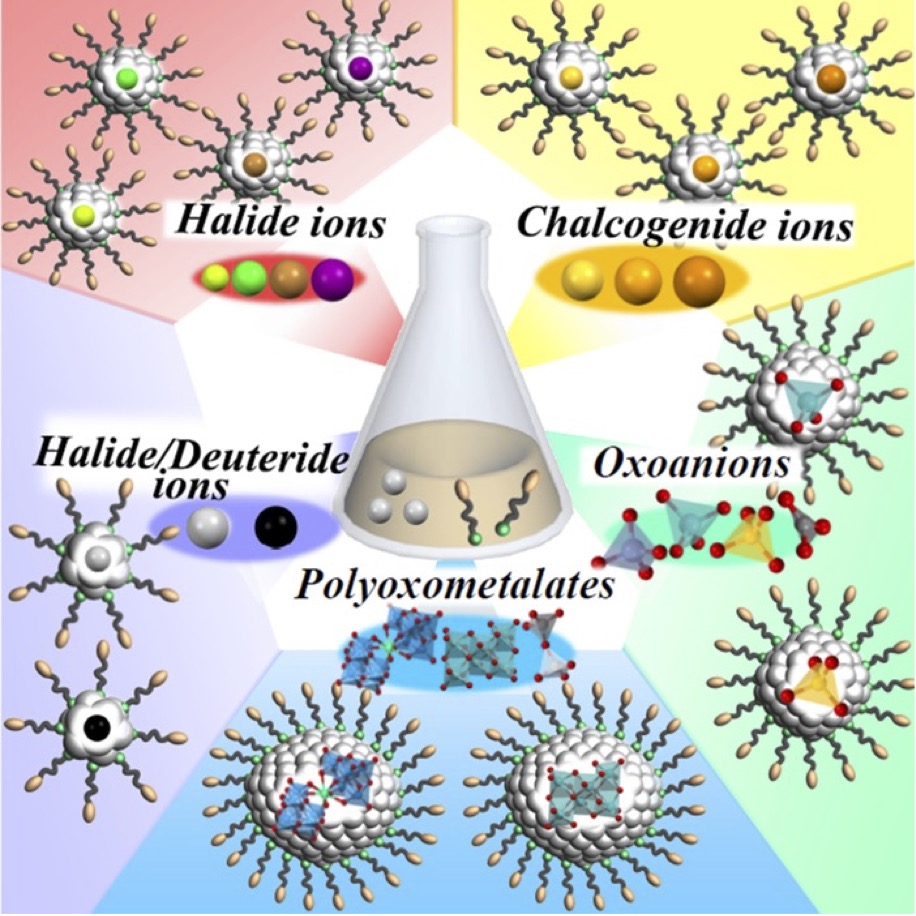
24)"Vertex-Shared Linear Superatomic Molecules: Stepping Stones to
Novel Materials Composed of Noble Metal Clusters"
Y. Niihori, S. Miyajima, A. Ikeda, T. Kosaka, Y. Negishi*
Small Sci. 3, 2370009 (2023).
Invited Review (Invited by Editor, Dr. Sneha Rhode)
Selected as "Outiside Front Cover"
Extremely small metal clusters composed of noble metal atoms (M) have the orbitals similar to those of atoms and therefore can be thought of as artificial atoms or superatoms. If these superatoms can be assembled into molecular analogues, it might be possible to create materials with new characteristics and properties that are different from those of existing substances. Therefore, the concept of superatomic molecules has attracted significant attention. The present review focuses on vertex-shared linear M12n+1 superatomic molecules formed via the sharing of a single metal atom between M13 superatoms having icosahedral cores and summarizes the knowledge obtained to date in this regard. This summary discusses the most suitable ligand combinations for the synthesis of M12n+1 superatomic molecules along with the valence electron numbers, stability, optical absorption characteristics and luminescence properties of the M12n+1 superatomic molecules fabricated to date. This information is expected to assist in the production of many M12n+1 superatomic molecules with novel structures and physicochemical properties in the future.
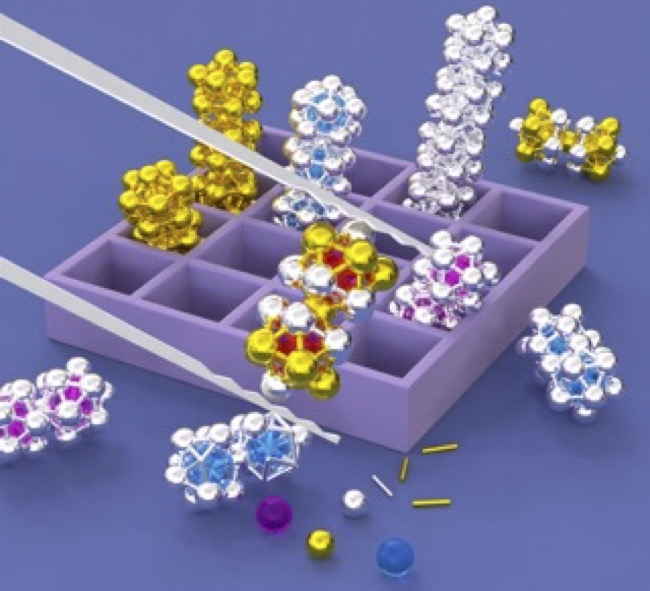
23)"Promoting Photocatalytic Carbon-Dioxide Reduction by Tuning the
Properties of Cocatalysts"
T. Kawawaki, Y. Akinaga, D. Yazaki, H. Kameko, D. Hirayama, Y. Negishi*
Chem. Euro. J. 29, e202203387 (2023).
Invited "Review" to special collection "Photocatalysis for a Brighter Future"
Selected as "Inside Cover"
Selected as "Chemistry Europe Reviews"
Selected as "Editors' Choice: Spotlights"
Selected as "Hot Topic: Carbon Dioxide"
Selected as "Hot Topic: Photocatalysts"
Selected as "Review Showcase"
Highlighted in "Frontispiece"
Suppressing the amount of carbon dioxide (CO2) in the atmosphere is an
essential measure toward addressing global warming. Specifically, photocatalytic
CO2 reduction reaction (CRR) is an effective strategy because it affords
the conversion of CO2 into useful carbon feedstocks using sunlight and
water. However, the practical application of photocatalyst-promoting CRR
(CRR photocatalysts) requires significant improvement of their conversion
efficiency. Accordingly, extensive research is being conducted toward the
improvement of semiconductor photocatalysts, as well as cocatalysts that
are loaded as active sites on the photocatalysts. In this review, we summarize
recent research and development trends on the improvement of cocatalysts,
which have a significant impact on the catalytic activity and selectivity
of photocatalytic CRR. We expect that the advanced knowledge provided on
the improvement of cocatalysts for CRR in this review will serve as a general
guideline to accelerate the development of highly efficient CRR photocatalysts.
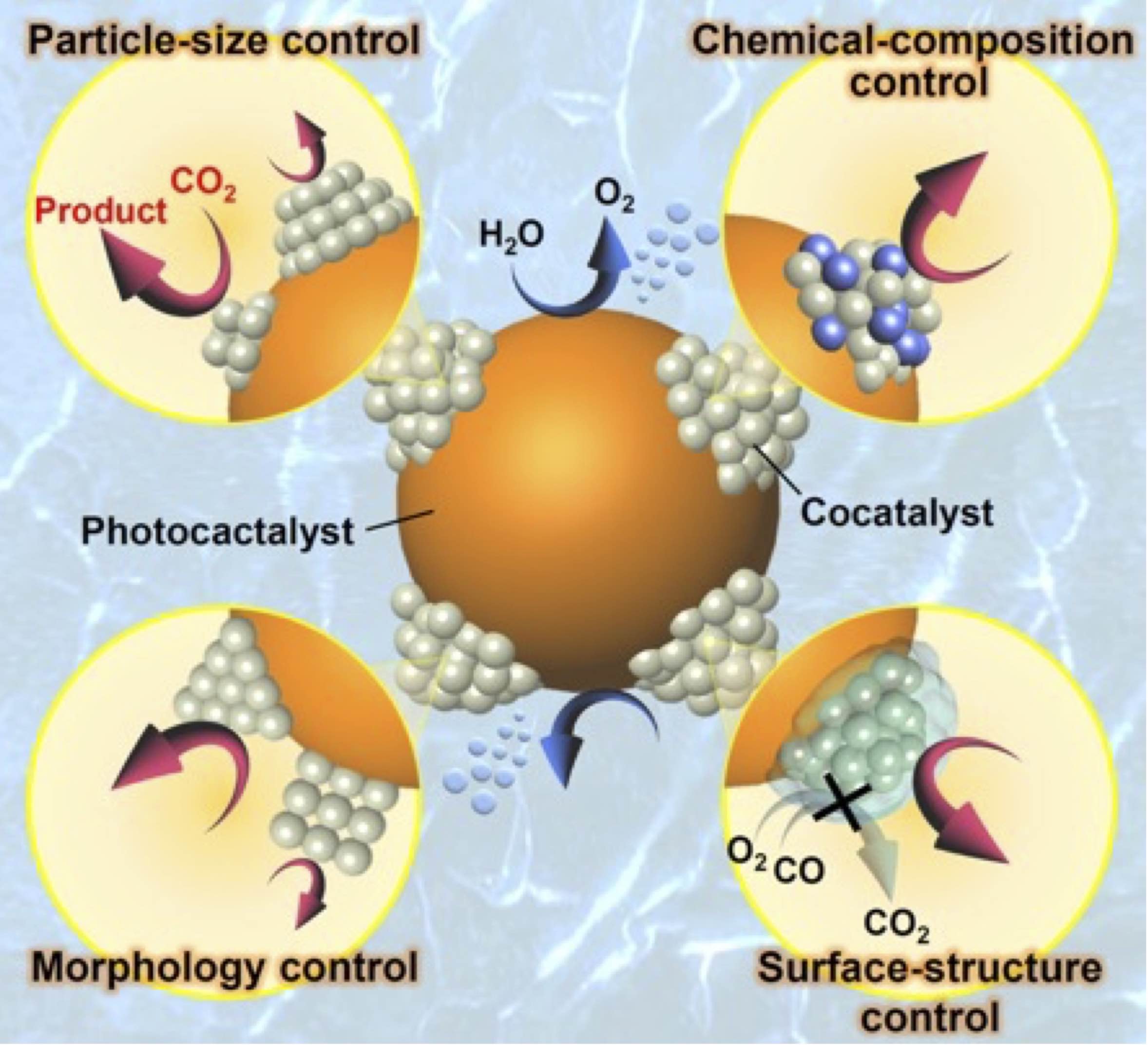
22)"Atomically Precise Thiolate-Protected Gold Nanoclusters: Current
Status of Designability of the Structure and Physicochemical Properties"
S. Hossain, D. Hirayama, A. Ikeda, M. Ishimi, S. Funaki, A. Samanta, T.
Kawawaki, Y. Negishi*
Aggregate, 4, e255 (2023).
Invited Review (Invited by Editor-in-Chief, Prof. Ben Zhong Tang)
Selected as "Inside Front Cover"
Thiolate (SR)-protected gold nanoclusters (Aun(SR)m NCs) are a rare type
of material capable of simultaneously exhibiting multiple physicochemical
properties well-suited to specific applications, including photoluminescence,
thermocatalysis, electrocatalysis, photocatalysis, magnetism and optical
activity. Over the past several decades, there has been tremendous progress
in our understanding of the structure and physicochemical properties of
Aun(SR)m NCs, resulting in the ability to fine-tune the characteristics
of these materials. It is therefore helpful to examine the extent to which
the properties of Aun(SR)m and related metal NCs can now be adjusted based
on design. This review presents representative examples of previous studies
concerning the geometry, electronic structure, luminescence properties,
catalysis, magnetism and optical activity of Aun(SR)m and related metal
NCs, and discusses the current status of the designability of these NCs
to impart specific structural and physicochemical characteristics. This
information is expected to accelerate the fabrication of highly functional
materials based on Aun(SR)m and related metal NCs.
.jpg)
21)"Metal-nanocluster Science and Technology: My Personal History
and Outlook"
Y. Negishi
Phys. Chem. Chem. Phys, 24, 7569-7594 (2022).
Invited "Perspective"
Selected as "Outside Front Cover"
Selected as "2022 HOT Article"
Metal nanoclusters (NCs) are among the leading targets in research of nanoscale
materials, and elucidation of their properties (science) and development
of control techniques (technology) have been continuously studied for the
past 60 years or so. I have been continuously studying metal NCs since
1995 while changing my own interests, and thereby research topics, according
to development of the field and the global situation. Specifically, I started
my research on gas-phase metal NCs, and then investigated systematic isolation
of thiolate-protected gold NCs. Thereafter, I worked on development of
flexible and precise techniques for controlling ligand-protected metal
NCs and creation of highly functional energy and environmental catalysts
using ligand-protected metal NCs. This personal account summarizes my previous
studies on metal NCs. Through this personal history, I would like to describe
my motivation for each previous subject, what type of research I want to
perform for each subject in the future, and how I consider the outlook
of the field.
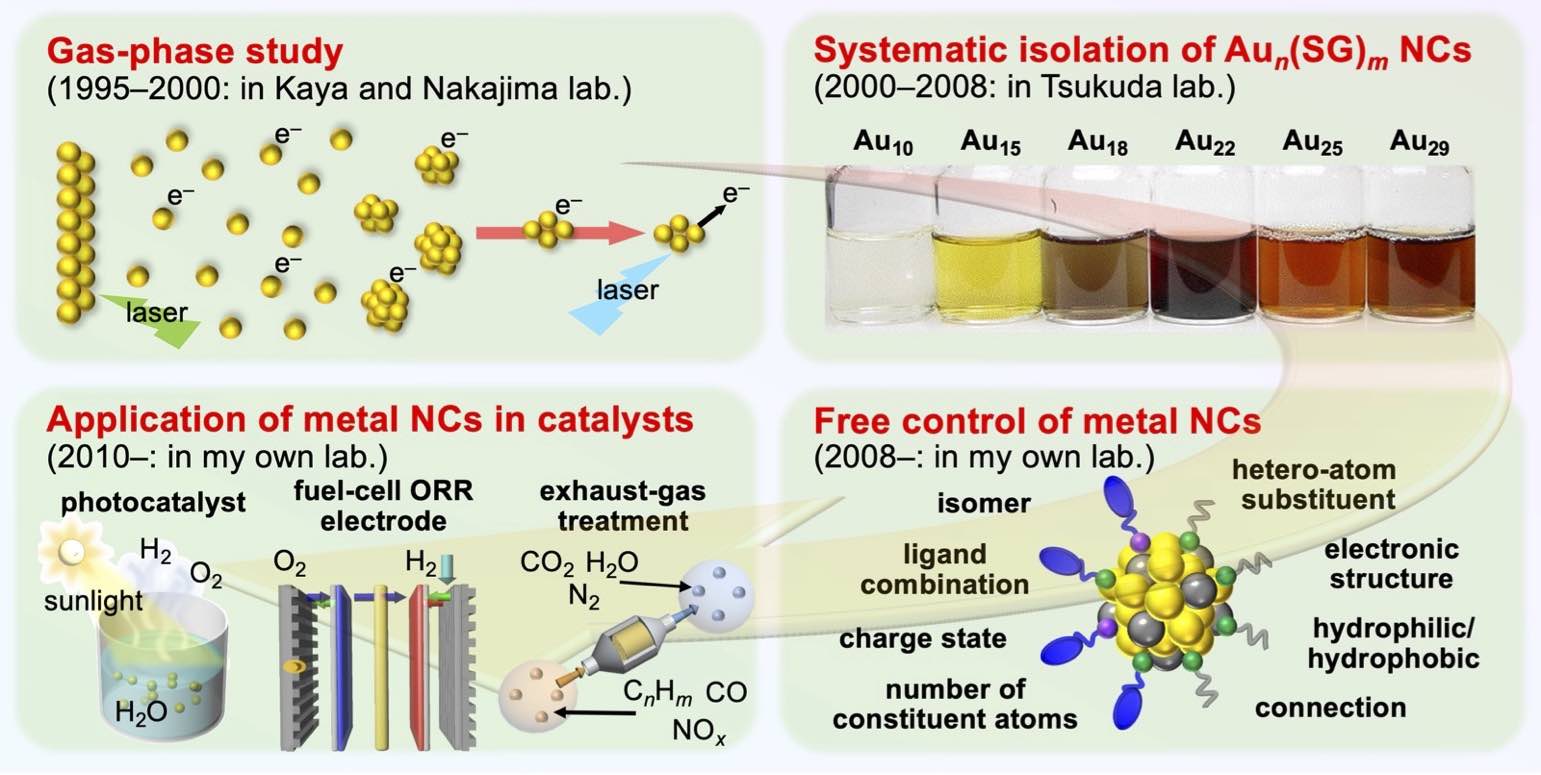
20)"Development and Functionalization of Visible-light-driven Water-splitting
Photocatalysts"
T. Kawawaki, M. Kawachi, D. Yazaki, Y. Akinaga, D. Hirayama, Y. Negishi*
Nanomaterials, 12, 344 (2022).
Invited Review to Special Issue "Advanced Nanomaterials for Water Splitting"
Highlighted in "Inside Cover"
Highlighted in "Nanomaterials MDPI Twitter"
With global warming and the depletion of fossil resources, our fossil-fuel-dependent
society is expected to shift to one that instead uses hydrogen (H2) as
a clean and renewable energy. To realize this, the photocatalytic water-splitting
reaction, which produces H2 from water and solar energy through photocatalysis,
has attracted much attention. However, for practical use, the functionality
of water-splitting photocatalysts must be further improved to efficiently
absorb visible (Vis) light, which accounts for the majority of sunlight.
Considering the mechanism of wa-ter-splitting photocatalysis, the researchers
in the various fields must be employed in this type of study for achieving
this. However, for researchers in the fields other than catalytic chemistry,
ce-ramic (semiconductor) materials chemistry, electrochemistry, to newly
participate in this field, new reviews that summarize previous reports
on water-splitting photocatalysis seems to be needed. Therefore, in this
review, we summarize recent studies on the development and function-alization
of Vis-light-driven water-splitting photocatalysts. Through this summary,
we aim to share current technology and future challenges with readers in
the various fields, and help expe-dite the practical application of Vis-light-driven
water-splitting photocatalysts.
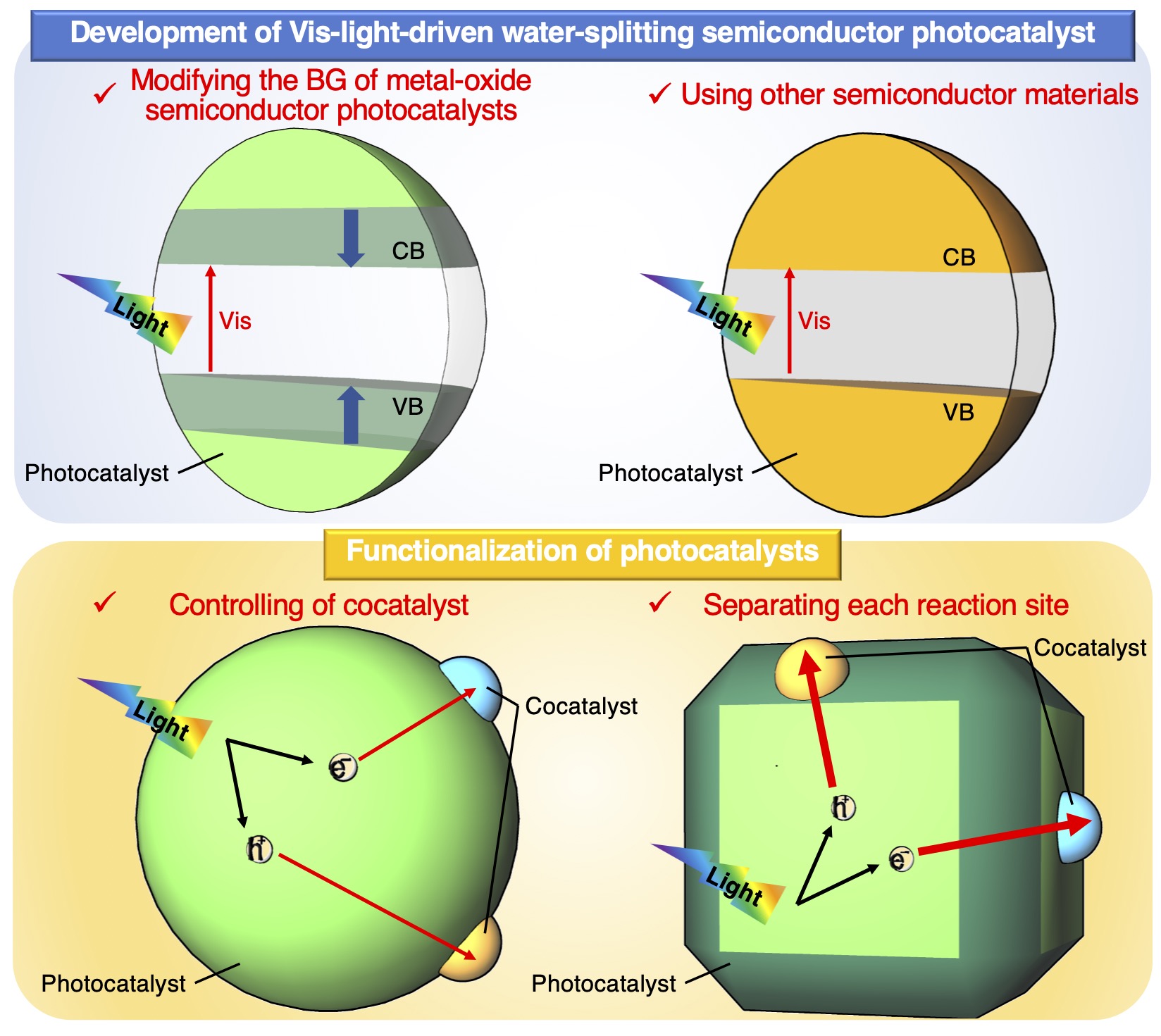
19)"Supported, ~1-nm-Sized Platinum Clusters: Controlled Preparation
and Enhanced Catalytic Activity"
T. Kawawaki, N. Shimizu, Y. Mitomi, D. Yazaki, S. Hossain, Y. Negishi*
Bull. Chem. Soc. Jpn, 94, 2853-2870 (2021).
Invited Accunt to Special Issue "Masterpiece Materials with Functional Excellence"
Highlighted in "Inside Cover"(Twittter 1/2)
Highlighted in "Account/Review Collection 2020-2021"
We have been aiming to reduce the amount of platinum (Pt) needed in catalysts
for automobile exhaust-gas purification and fuel cell electrodes. To achieve
this, we have attempted to: 1) establish simple methods for synthesizing
ligand-protected ~1-nm-sized Pt clusters with a narrow distribution in
the number of constituent atoms; 2) load these clusters onto supports,
while retaining their number of constituent atoms, to prepare supported
~1-nm-sized Pt clusters; and 3) elucidate the catalytic activity of each
type of supported ~1-nm-sized Pt cluster. These studies have revealed that:
1) ligand-protected ~1-nm-sized Pt clusters stable in the atmosphere can
be isolated with high purity by a combination of polyol reduction and ligand-exchange
reaction; 2) ~1-nm-sized Pt clusters can be loaded onto the support without
aggregation when the clusters are adsorbed on the support and then calcined
at an appropriate temperature; and 3) Pt17 clusters loaded onto γ-alumina
exhibit high activity and durability for exhaust-gas purification, whereas
Ptn clusters (n = ~35, ~51, or ~66) loaded onto carbon black exhibit high
activity and durability for the oxygen reduction reaction (which occurs
at fuel cell electrodes). This account describes our previous studies and
explores future prospects for supported ~1-nm-sized Pt clusters.
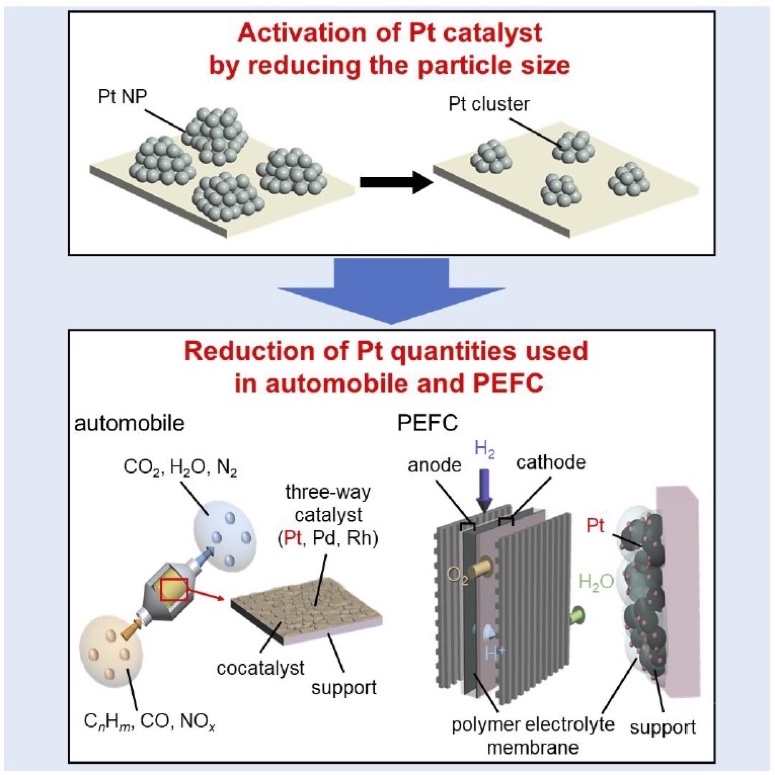
18)"Thiolate-Protected Metal Nanoclusters: Recent Development in Synthesis,
Understanding of Reaction, and Application in Energy and Environmental
Field"
T. Kawawaki, A. Ebina, Y. Hosokawa, S. Ozaki, D. Suzuki, S. Hossain, Y.
Negishi*
Small 17, 202005328 (2021).
Invited Review to "Special Issue"
Selected as"Frontispiece"
Selected as "Hot Topic: Water Splitting"
Metal nanoclusters (NCs), which are composed of about 250 or fewer metal
atoms, possess great potential as novel functional materials. Fundamental
research on metal NCs gradually started in the 1960s, and since 2000, thiolate
(SR)-protected metal NCs have been the main metal NCs actively studied.
The precise and systematic isolation of SR-protected metal NCs has been
achieved in 2005. Since then, research on SR-protected metal NCs for both
basic science and practical application has rapidly expanded. This review
describes this recent progress in the field of SR-protected metal NCs in
three areas: synthesis, understanding, and application. Specifically, the
recent study of alloy NCs and connected structures composed of NCs is highlighted
in the “synthesis” section, recent knowledge on the reactivity of NCs in
solution is highlighted in the “understanding” section, and the applications
of NCs in the energy and environmental field are highlighted in the “application”
section. This review provides insight on the current state of research
on SR-protected metal NCs and discusses the challenges to be overcome for
further development in this field as well as the possibilities that these
materials can contribute to solving the problems facing modern society.
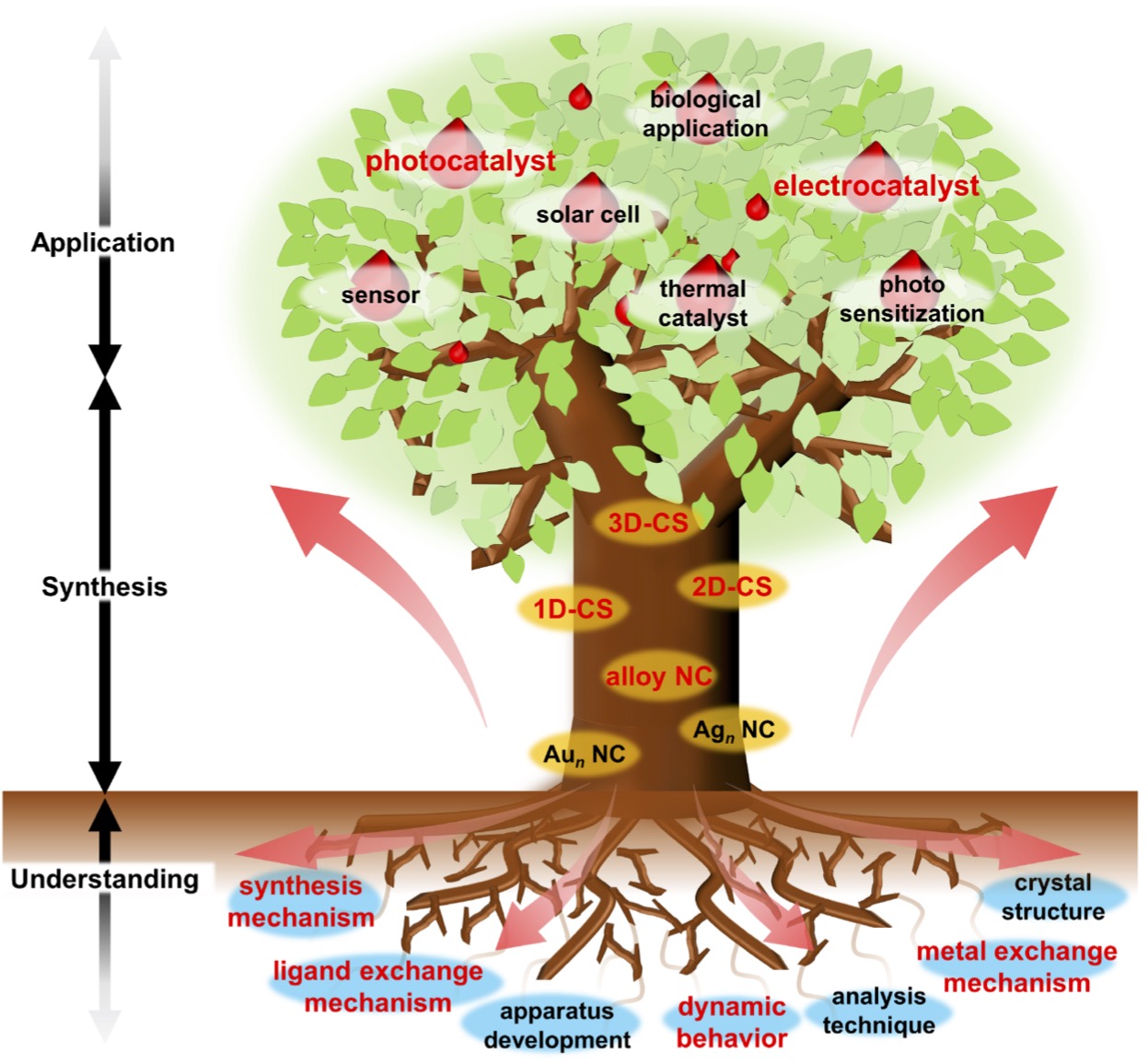
17)"Toward the Creation of High-performance Heterogeneous Catalysts
by Controlled Ligand Desorption from Atomically Precise Metal Nanoclusters"
T. Kawawaki, Y. Kataoka, M. Hirata, Y. Iwamatsu, S. Hossain, Y. Negishi*
Nanoscale Horiz. 6, 409-448 (2021).
Invited "Review"
Selected as "Outside Front Cover"
Selected as "Nanoscale 2022 Lunar New Year Collection"
Selected as "Nanoscale Most Popular 2021 Articles"
Top 10% of highly cited articles from the Royal Society of Chemistry
Ligand-protected metal nanoclusters controlled by atomic accuracy (i. e.
atomically precise metal NCs) have recently attracted considerable attention
as active sites in heterogeneous catalysts. Using these atomically precise
metal NCs, it becomes possible to create novel heterogeneous catalysts
based on a size-specific electronic/geometrical structure of metal NCs
and understand the mechanism of the catalytic reaction easily. However,
to create high-performance heterogeneous catalysts using atomically precise
metal NCs, it is often necessary to remove the ligands from the metal NCs.
This review summarizes previous studies on the creation of heterogeneous
catalysts using atomically precise metal NCs while focusing on the calcination
as a ligand-elimination method. Through this summary, we intend to share
state-of-art techniques and knowledge on (1) experimental conditions suitable
for creating high-performance heterogeneous catalysts (e.g., support type,
metal NC type, ligand type, and calcination temperature), (2) the mechanism
of calcination, and (3) the mechanism of catalytic reaction over the created
heterogeneous catalyst. We also discuss (4) issues that should be addressed
in the future toward the creation of high-performance heterogeneous catalysts
using atomically precise metal NCs. The knowledge and issues described
in this review are expected to lead to clear design guidelines for the
creation of novel heterogeneous catalysts.
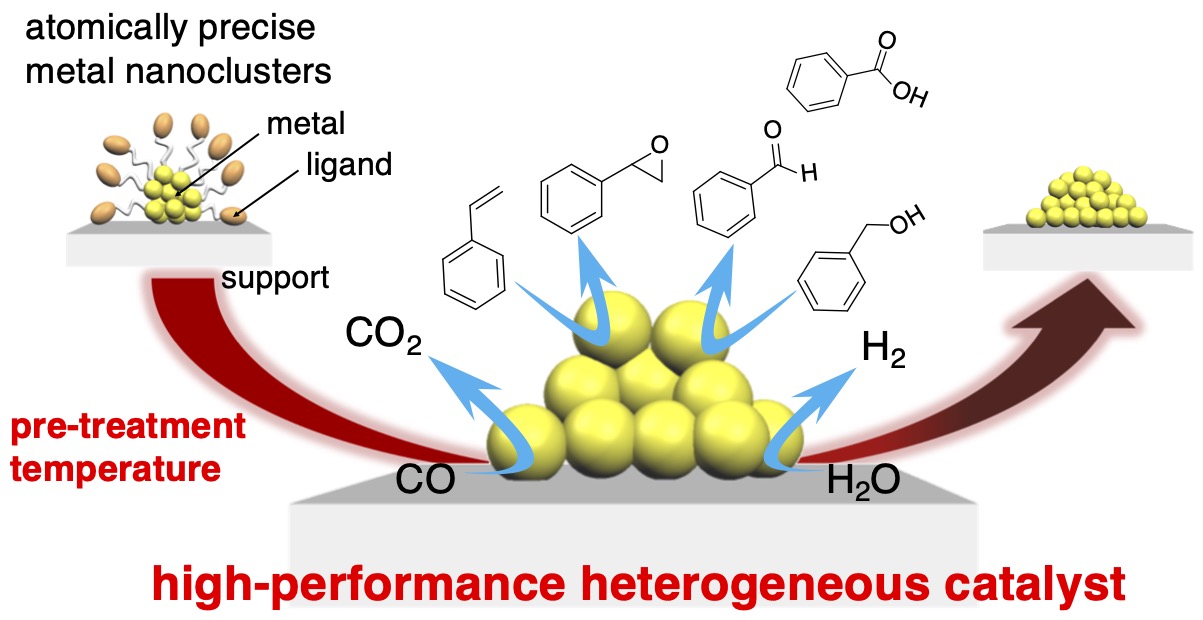
16)"Creation of Active Water-splitting Photocatalysts by Controlling
Cocatalysts Using Atomically Precise Metal Nanoclusters"
T. Kawawaki,Y. Kataoka, S. Ozaki, M. Kawachi, M. Hirata, Y. Negishi*
Chem. Commun. 57, 417-44 (2021).
Invited "Feature Article"
Selected as "Inside Front Cover"
With global warming and the depletion of fossil resources, our fossil-fuel-dependent society is expected to shift to one that instead uses hydrogen (H2) as clean and renewable energy. Water-splitting photocatalysts can produce H2 from water using sunlight, which are almost infinite on the earth. However, further improvements are indispensable to enable their practical application. To improve the efficiency of the photocatalytic water-splitting reaction, in addition to improving the semiconductor photocatalyst, it is extremely effective to improve the cocatalysts (loaded metal nanoclusters, NCs) that enable the reaction to proceed on the photocatalysts. We have thus attempted to strictly control metal NCs on photocatalysts by introducing the precise-control techniques of metal NCs established in the metal NC field into research on water-splitting photocatalysts. Specifically, the cocatalysts on the photocatalysts were controlled by adsorbing atomically precise metal NCs on the photocatalysts and then removing the protective ligands by calcination. This work has led to several findings on the electronic/geometrical structures of the loaded metal NCs, the correlation between the types of loaded metal NCs and the water-splitting activity, and the methods for producing high water-splitting activity. We expect that the obtained knowledge will lead to clear design guidelines for the creation of practical water-splitting photocatalysts and thereby contribute to the construction of a hydrogen-energy society.
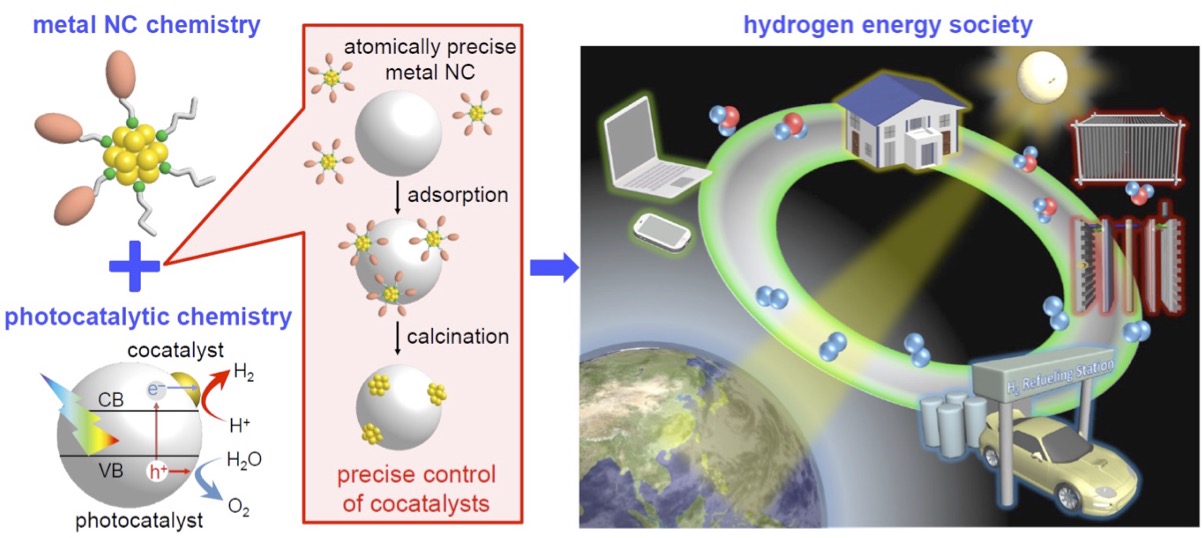
15)"Atomically Precise Alloy Nanoclusters"
T. Kawawaki, Y. Imai, D. Suzuki, S. Kato, I. Kobayashi, T. Suzuki, R.
Kaneko, S. Hossain, Y. Negishi*
Chem. Euro. J. 26, 16150-16193 (2020).
Invited "Review"
Selected as "Front Cover" and "Cover Profile"
Selected as "Hot Topic: Gold"
Highlighted in "Frontispiece"
Metal nanoclusters (NCs) have a particle size of about one nanometer, which
makes them the smallest unit that can give a function to a substance. In
addition, metal NCs possess physical and chemical properties that are different
from those of the corresponding bulk metals. Metal NCs with such characteristics
are expected to be important for use in nanotechnology. Research on the
precise synthesis of metal NCs and elucidation of their physical/chemical
properties and functions is being actively conducted. When metal NCs are
alloyed, it is possible to obtain further various electronic and geometrical
structures and functions. Thus, research on alloy NCs has become a hot
topic in the study of metal NCs and the number of publications on alloy
NCs has increased explosively in recent years. Such publications have provided
much insight into the effects of alloying on the electronic structure and
function of metal NCs. However, the rapid increase in knowledge has made
it difficult for researchers (especially those new to the field) to grasp
all of it. Therefore, in this review, we summarize the reported chemical
composition, geometrical structure, electronic structure, and physical
and chemical properties of Aun−xMx(SR)m, Agn−xMx(SR)m, Aun−xMx(PR3)l(SR)m,
and Agn−xMx(PR3)l(SR)m (Au=gold, Ag=silver, M=heteroatom, PR3=phosphine,
and SR=thiolate) NCs. This review is expected to help researchers understand
the characteristics of alloy NCs and lead to clear design guidelines to
develop new alloy NCs with intended functions.
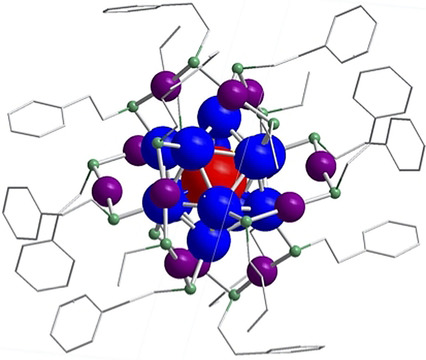
14)"Controlled Colloidal Metal Nanoparticles and Nanoclusters: Recent
Applications as Cocatalysts for Improving Photocatalytic Water-splitting
Activity"
T. Kawawaki, Y. Mori, K. Wakamatsu, S. Ozaki, M. Kawachi, S. Hossain, Y.
Negishi*
J. Mater. Chem. A, 8, 16081-16113 (2020)..
Invited "Review"
Top 5% of highly cited works from Japanese institutions
In recent years, research on the use of metal nanoparticles (NPs) and nanoclusters
(NCs) synthesized by liquid-phase reduction in water-splitting photocatalysts
has been actively conducted. Water-splitting photocatalysts have been attracting
attention because they can produce hydrogen (H2), which is attractive as
a next-generation energy source, from solar energy and water. However,
further improvement of water-splitting photocatalysts is required for their
practical use in society. Recent studies have demonstrated that the active
sites (cocatalysts) of water-splitting photocatalysts can be controlled
using the advanced NP/NC syntheses and structural modulation techniques
established in the fields of colloid, NP, and NC chemistry and thereby
highly active water-splitting photocatalysts can be developed. If such
research progresses further, it is expected that a transition to a new
society using H2 as the main energy source will become possible. However,
such applied research has just started and examples of such research are
currently limited. The purpose of this review is to introduce the importance
of controlled colloidal NPs/NCs in research on water-splitting photocatalysis
to readers by summarizing the existing research. We hope that this review
will raise interest in the application of metal NPs/NCs in water-splitting
photocatalysis and that a society actively addressing energy and environmental
problems will become a reality as soon as possible.
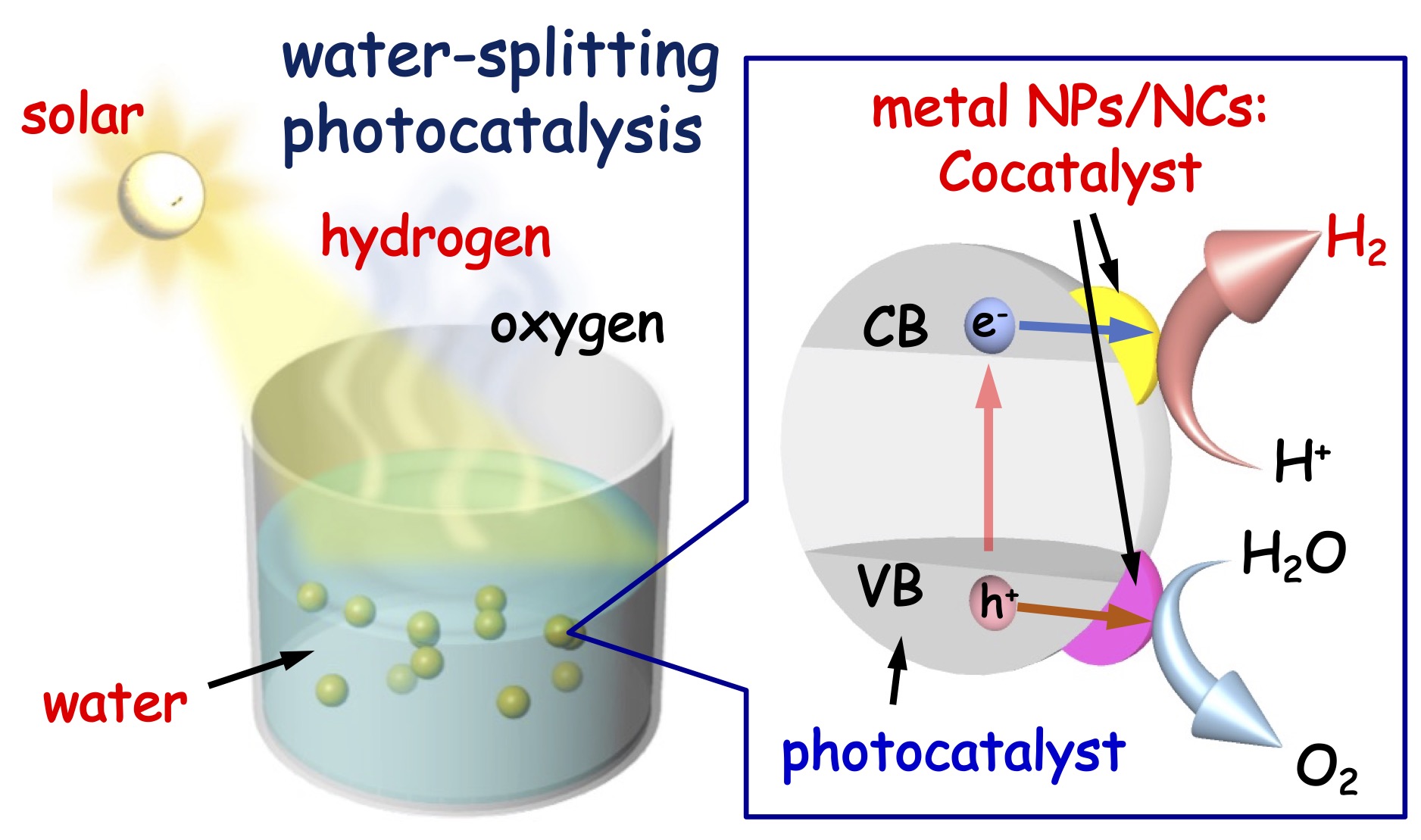
13)"One-, Two-, and Three-Dimensional Self-Assembly of Atomically
Precise Metal Nanoclusters"
A. Ebina, S. Hossain, H. Horihata, S. Ozaki, S. Kato, T. Kawawaki, Y.
Negishi*
Nanomaterials, 10, 1105, (2020).
Invited Review to "Special Issue"
Metal nanoclusters (NCs), which consist of several, to about one hundred,
metal atoms, have attracted much attention as functional nanomaterials
for use in nanotechnology. Because of their fine particle size, metal NCs
exhibit physical/chemical properties and functions different from those
of the corresponding bulk metal. In recent years, many techniques to precisely
synthesize metal NCs have been developed. However, to apply these metal
NCs in devices and as next-generation materials, it is necessary to assemble
metal NCs to a size that is easy to handle. Recently, multiple techniques
have been developed to form one-, two-, and three-dimensional connected
structures (CSs) of metal NCs through self-assembly. Further progress of
these techniques will promote the development of nanomaterials that take
advantage of the characteristics of metal NCs. This review summarizes previous
research on the CSs of metal NCs. We hope that this review will allow readers
to obtain a general understanding of the formation and functions of CSs
and that the obtained knowledge will help to establish clear design guidelines
for fabricating new CSs with desired functions in the future.
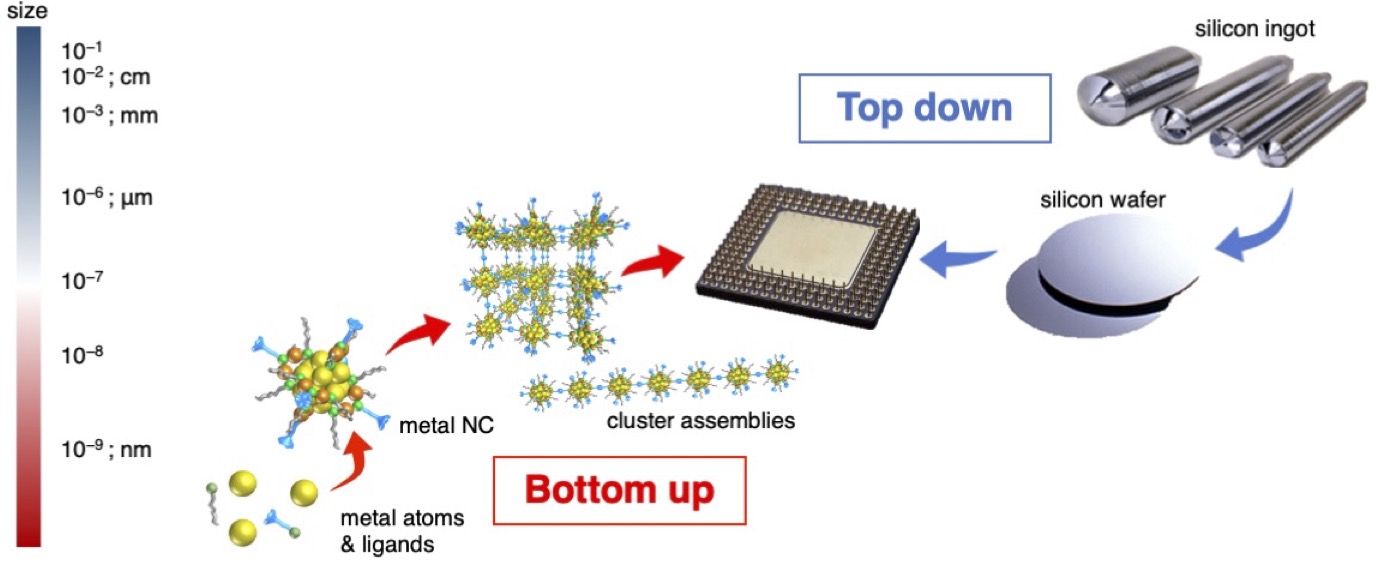
12)"Atomic-level Separation of Thiolate-protected Metal Clusters"
Y. Negishi,* S. Hashimoto, A. Ebina, K. Hamada, S. Hossain, T. Kawawaki
Nanoscale, 12, 8017-8039 (2020).
Invited "Review"
Selected as "Inside Front Cover"
Fine metal clusters have attracted much attention from the viewpoints of
both basic and applied science for many years because of their unique physical/chemical
properties and functions, which differ from those of bulk metals. Among
these materials, thiolate (SR)-protected gold clusters (Aun(SR)m clusters)
have been the most studied metal clusters since 2000 because of their ease
of synthesis and handling. However, in the early 2000s, it was not easy
to isolate these metal clusters. Therefore, high-resolution separation
methods were explored, and several atomic-level separation methods, including
polyacrylamide gel electrophoresis (PAGE), high-performance liquid chromatography
(HPLC), and thin-layer chromatography (TLC), were successively established.
These techniques have made it possible to isolate a series of Aun(SR)m
clusters, and much knowledge has been obtained on the correlation between
the chemical composition and fundamental properties such as the stability,
electronic structure, and physical properties of Aun(SR)m clusters. In
addition, these high-resolution separation techniques are now also frequently
used to evaluate the distribution of the product and to track the reaction
process. In this way, high-resolution separation techniques have played
an essential role in the study of Aun(SR)m clusters. However, only a few
reviews have focused on this work. This review focuses on PAGE, HPLC, and
TLC separation techniques, which offer high resolution and repeatability,
and summarizes previous studies on the high-resolution separation of Aun(SR)m
and related clusters with the purpose of promoting a better understanding
of the features and the utility of these techniques.
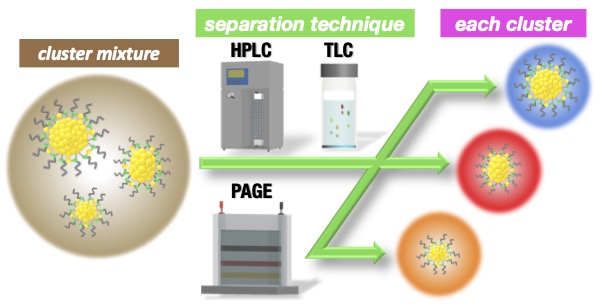
11)"Gold Nanoclusters as Electrocatalysts for Energy Conversion"
T. Kawawaki, Y. Negishi*
Nanomaterials, 10, 238 (2020).
Invited Review to "Special Issue"
Gold nanoclusters (Aun NCs) exhibit a size-specific electronic structure
unlike bulk gold and can therefore be used as catalysts in various reactions.
Ligand-protected Aun NCs can be synthesized with atomic precision, and
the geometric structures of many Aun NCs have been determined by single-crystal
X-ray diffraction analysis. In addition, Aun NCs can be doped with various
types of elements. Clarification of the effects of changes to the chemical
composition, geometric structure, and associated electronic state on catalytic
activity would enable a deep understanding of the active sites and mechanisms
in catalytic reactions as well as key factors for high activation. Furthermore,
it may be possible to synthesize Aun NCs with properties that surpass those
of conventional catalysts using the obtained design guidelines. With these
expectations, catalyst research using Aun NCs as a model catalyst has been
actively conducted in recent years. This review focuses on the application
of Aun NCs as an electrocatalyst and outlines recent research progress.
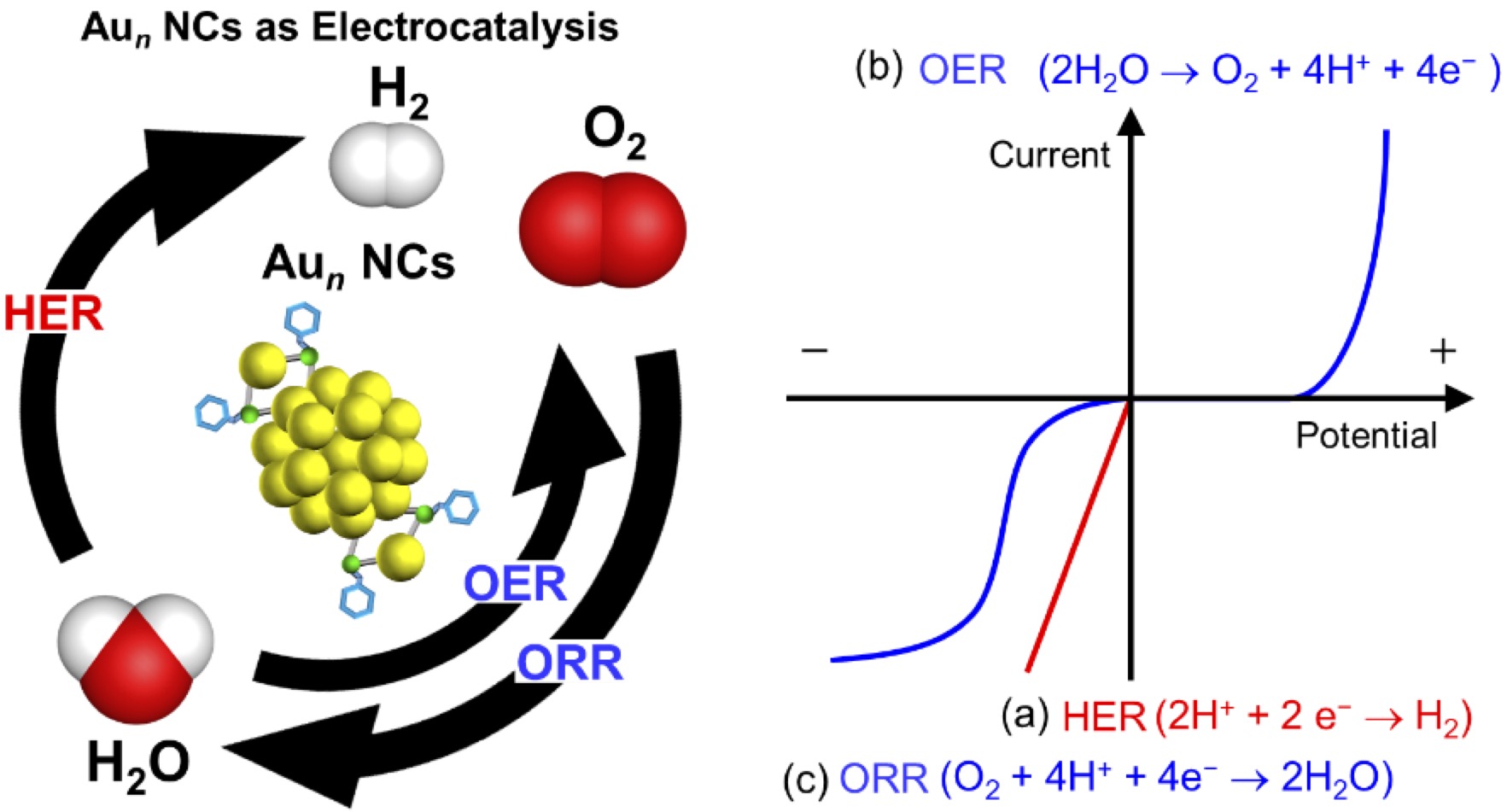
10)"Photo/electrocatalysis and Photosensitization Using Metal Nanoclusters
for Green Energy and Medical Applications"
T. Kawawaki, Y. Negishi*, H. Kawasaki*
Nanoscale Adv. 2, 17-36 (2020).
Invited "Review"
Selected as "Inside FrontCover"
Selected as a part of "Themed Collection: Photocatalysis and Photoelectrochemistry"
Selected as "Editor's Choice: Single-atom and nanocluster catalysis"
Top 5% of highly cited works from Japanese institutions
Owing to the rapidly increasing demand for sustainable technologies in
fields such as energy, environmental science, and medicine, nanomaterial-based
photo/electrocatalysis has received increasing attention. Recently, synthetic
innovations have allowed the fabrication of atomically precise metal nanoclusters
(NCs). These NCs show potential for green energy and medical applications.
The present article primarily focuses on evaluation of the recent developments
in the photo/electrocatalytic and photosensitizing characteristics of metal
and alloy NCs. The review comprises two sections: (i) photo/electrocatalysis
for green energy and (ii) photosensitization for biomedical therapy applications.
Finally, the challenges associated with the use of metal NCs are presented
on the basis of current developments.
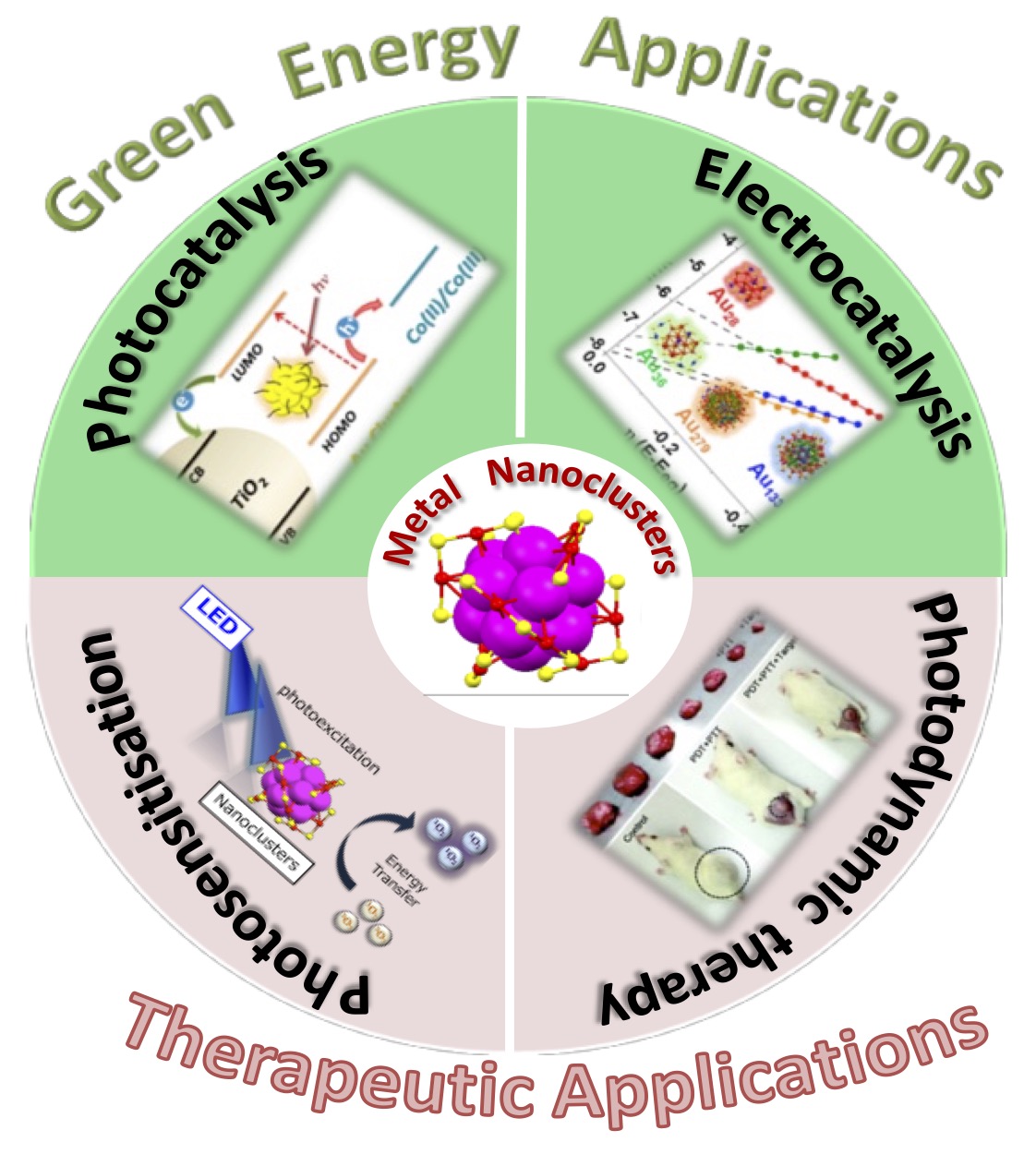
9)"Deepening the Understanding on Thiolate-Protected Metal Clusters
Using High-Performance Liquid Chromatography"
Y. Niihori, K. Yoshida, S. Hossain, W. Kurashige, Y. Negishi*
Bull. Chem. Soc. Jpn, 92, 664-695 (2019)..
Invited Accunt to Special Issue"Material Innovation"
HIghlighted in "Inside Cover"
HIghlighted in "Account/Review Collection 2019-20"
Thiolate (SR)-protected metal clusters have been extensively studied by
using various structural analysis methods since the start of research into
these clusters. We have also studied these clusters based on common analysis
methods used by many other research groups. However, we also have actively
worked towards efficient application of high-performance liquid chromatography
(HPLC) to study these clusters. Consequently, we have achieved high-resolution
separations of several SR-protected gold and alloy clusters. By realizing
such high-resolution separations, we have achieved a deeper understanding
of a number of issues, including: 1) the transition size from bulk to non-bulk
behavior in dodecanethiolate-protected gold clusters; 2) heteroatom substitution
effects on the electronic structures and the dependence of isomer distributions
on experimental conditions in hydrophobic SR-protected alloy clusters;
3) the mechanism of ligand-exchange reactions in hydrophobic metal clusters;
and 4) the chemical composition of products in hydrophilic metal clusters.
These results have clearly demonstrated that HPLC separation and analysis
are extremely effective in helping to understand the fundamental properties
of SR-protected metal clusters.
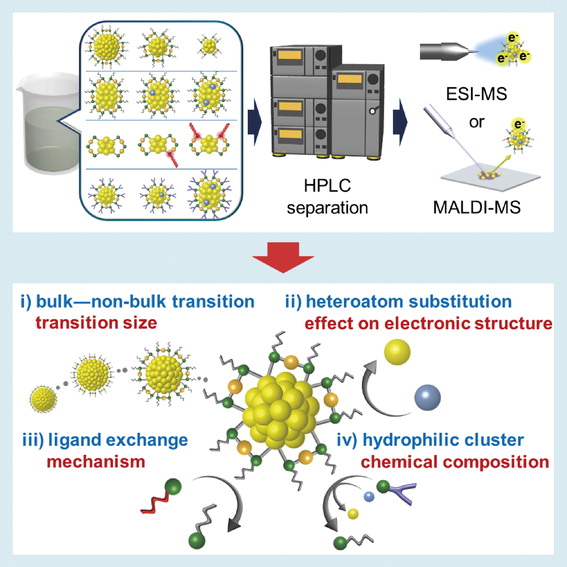
8)"Alloy Clusters: Precise Synthesis and Mixing Effects"
S. Hossain, Y. Niihori, L. V. Nair, B. Kumar, W. Kurashige, Y. Negishi*
Acc. Chem. Res., 51, 3114-3124 (2018).
Invited Article to Special Issue"Toward Atomic Precision in Nanoscience"
Selected as "Supplementary Cover"
Metal alloys exhibit functionalities unlike those of single metals. Such alloying has drawn considerable research interest, particularly for nanoscale particles (metal clusters/nanoparticles), from the viewpoint of creating new functional nanomaterials. In gas phase cluster research, generated alloy clusters can be spatially separated with atomic precision in vacuum. Thus, the influences of increases or decreases in each element on the overall electronic structure of the cluster can be elucidated. However, to further understand the related mixing and synergistic effects, alloy clusters need to be produced on a large scale and characterized by various techniques. Because alloy clusters protected by thiolate (SR) can be synthesized by chemical methods and are stable in both solution and the solid state, these clusters are ideal study materials to better understand the mixing and synergistic effects. Moreover, the alloy clusters thus created have potential applications as functional materials. Therefore, since 2008, we have been working on establishing a precise synthesis method for SR-protected alloy clusters and elucidating their mixing and synergistic effects.
Early research focused on the precise synthesis of alloy clusters wherein some of the Au in the stable SR-protected gold clusters ([Au25(SR)18]− and [Au38(SR)24]0) is replaced by Pd, Ag, or Cu. These studies have shown that Pd, Ag, or Cu substitute at different metal sites. We also have examined the as-synthesized alloy clusters to clarify the effect of substitution by each element on the physical and chemical properties of the clusters. However, in early studies, the number of substitutions could not be controlled with atomic accuracy for [Au25–xMx(SR)18]− (M = Ag or Cu). Then, in following research, methods have been established to obtain alloy clusters with control over the composition. We have succeeded in developing a method for controlling the number of Ag substitutions with atomic precision and thereby elucidating the effect of Ag substitution on the electronic structure of clusters with atomic precision. Concurrently, we also studied alloy clusters containing multiple heteroelements with different preferential substitution sites. These results revealed that the effects of substitution of each element can be superimposed on the cluster by combining multiple elemental substitutions at different sites. In addition, we successfully developed methods to synthesize alloy clusters with heterometal core. These findings are expected to lead to clear design guidelines for developing new functional nanomaterials.
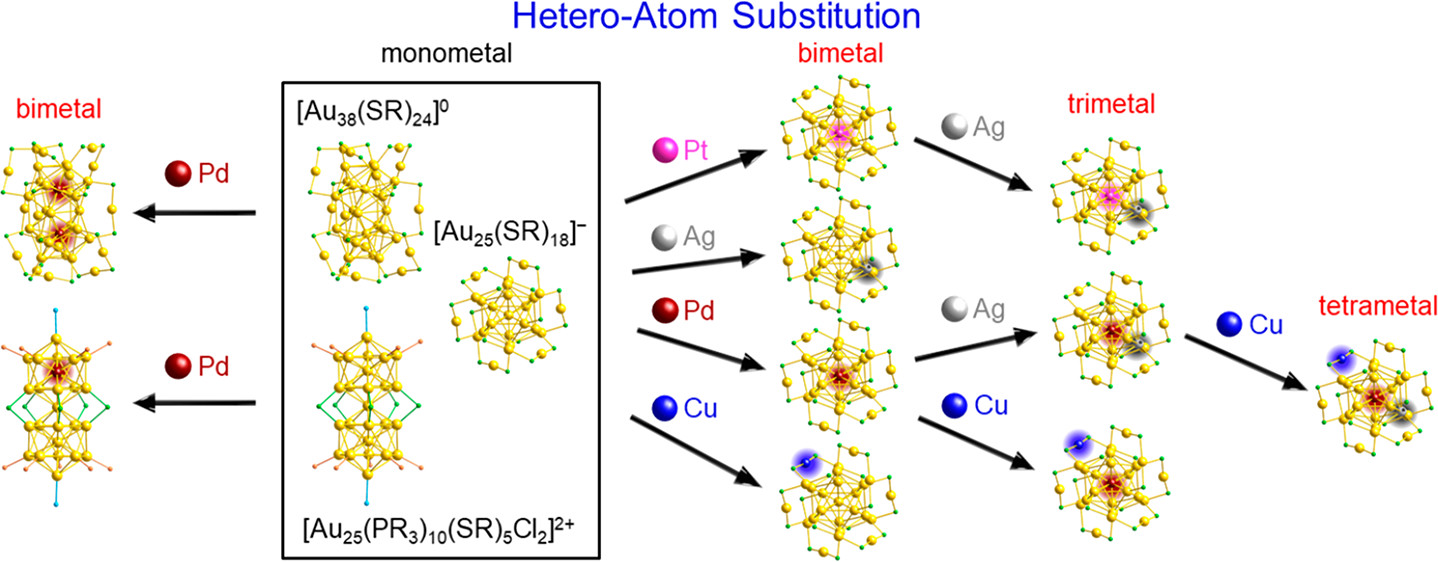
7)"Understanding and Practical Use of Ligand and Metal Exchange Reactions
in Thiolate-Protected Metal Clusters to Synthesize Controlled Metal Clusters"
Y. Niihori, S. Hossain, S. Sharma, B. Kumar, W. Kurashige, Y. Negishi*
Chem. Rec. (Personal Accounts), 17, 473-484 (2017).
Invited "Personal Accounts"
Selected as "Outside Front Cover"
It is now possible to accurately synthesize thiolate (SR)-protected gold
clusters (Aun(SR)m) with various chemical compositions with atomic precision.
The geometric structure, electronic structure, physical properties, and
functions of these clusters are well known. In contrast, the ligand or
metal atom exchange reactions between these clusters and other substances
have not been studied extensively until recently, even though these phenomena
were observed during early studies. Understanding the mechanisms of these
reactions could allow desired functional metal clusters to be produced
via exchange reactions. Therefore, we have studied the exchange reactions
between Aun(SR)m and analogous clusters and other substances for the past
four years. The results have enabled us to gain deep understanding of ligand
exchange with respect to preferential exchange sites, acceleration means,
effect on electronic structure, and intercluster exchange. We have also
synthesized several new metal clusters using ligand and metal exchange
reactions. In this account, we summarize our research on ligand and metal
exchange reactions.
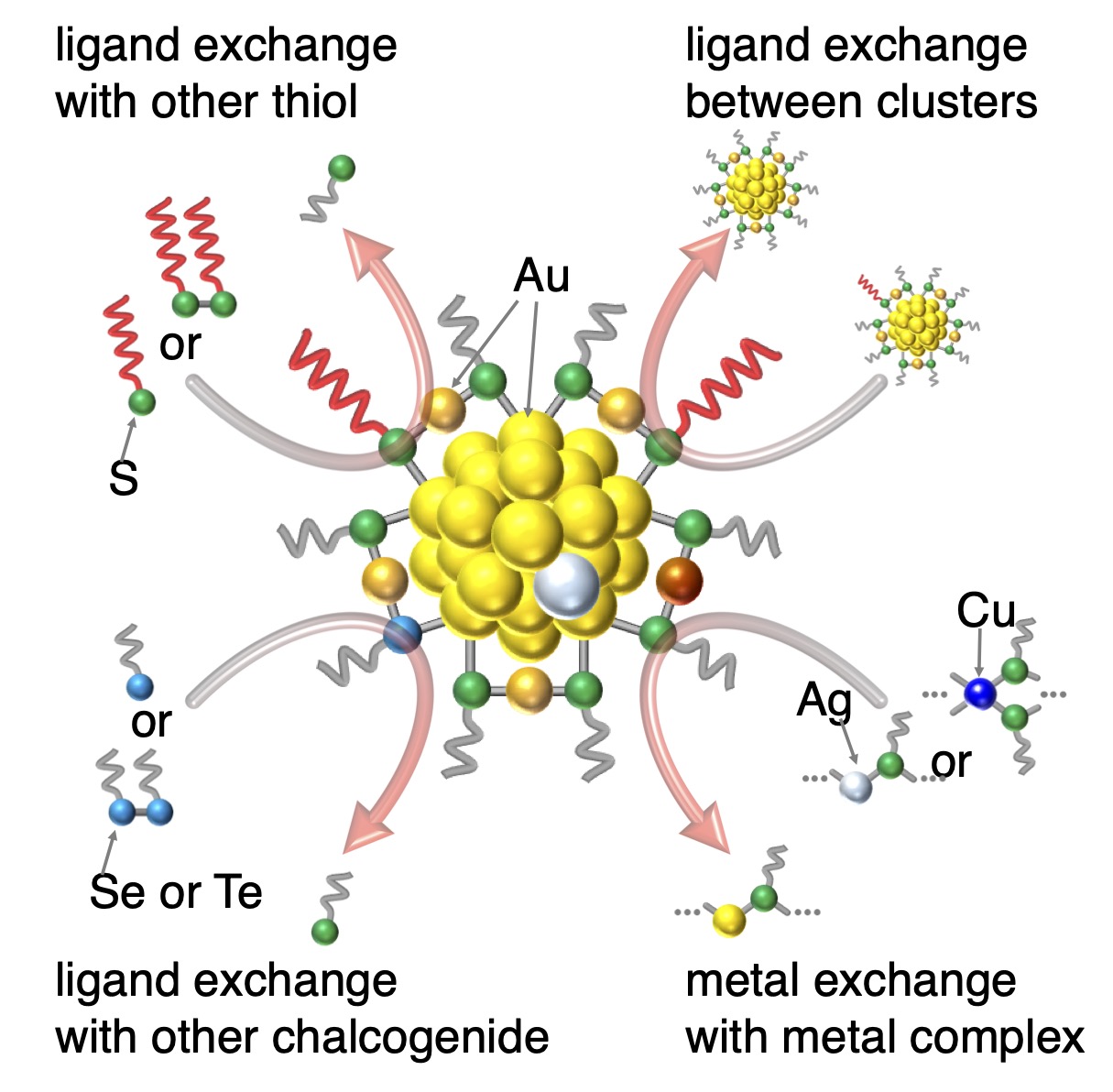
6)"Perspective: Exchange Reactions in Thiolate-Protected Metal Clusters"
Y. Niihori, S. Hossain, B. Kumar, L. V. Nair, W. Kurashige, Y. Negishi*
APL Mater. (Perspective), 5, 053201 (2017).
Invited "Perspective" to "Special Issue"
Highlighted in "Featured"
Thiolate-protected metal clusters can exchange ligands or metal atoms with
other substances such as coexisting ligands, complexes, and metal clusters
in solution. Using these reactions, it is possible to synthesize metal
clusters with new physical and chemical properties. Although the occurrence
of such reactions was recognized nearly 20 years ago, their details were
not well understood. In recent years, techniques for the precise synthesis
of metal clusters and their characterization have progressed considerably
and, as a result, details of these reactions have been clarified. In this
perspective, we focus on the most-studied thiolate-protected gold clusters
and provide a summary of recent findings as well as future expectations
concerning the exchange reactions of these clusters.
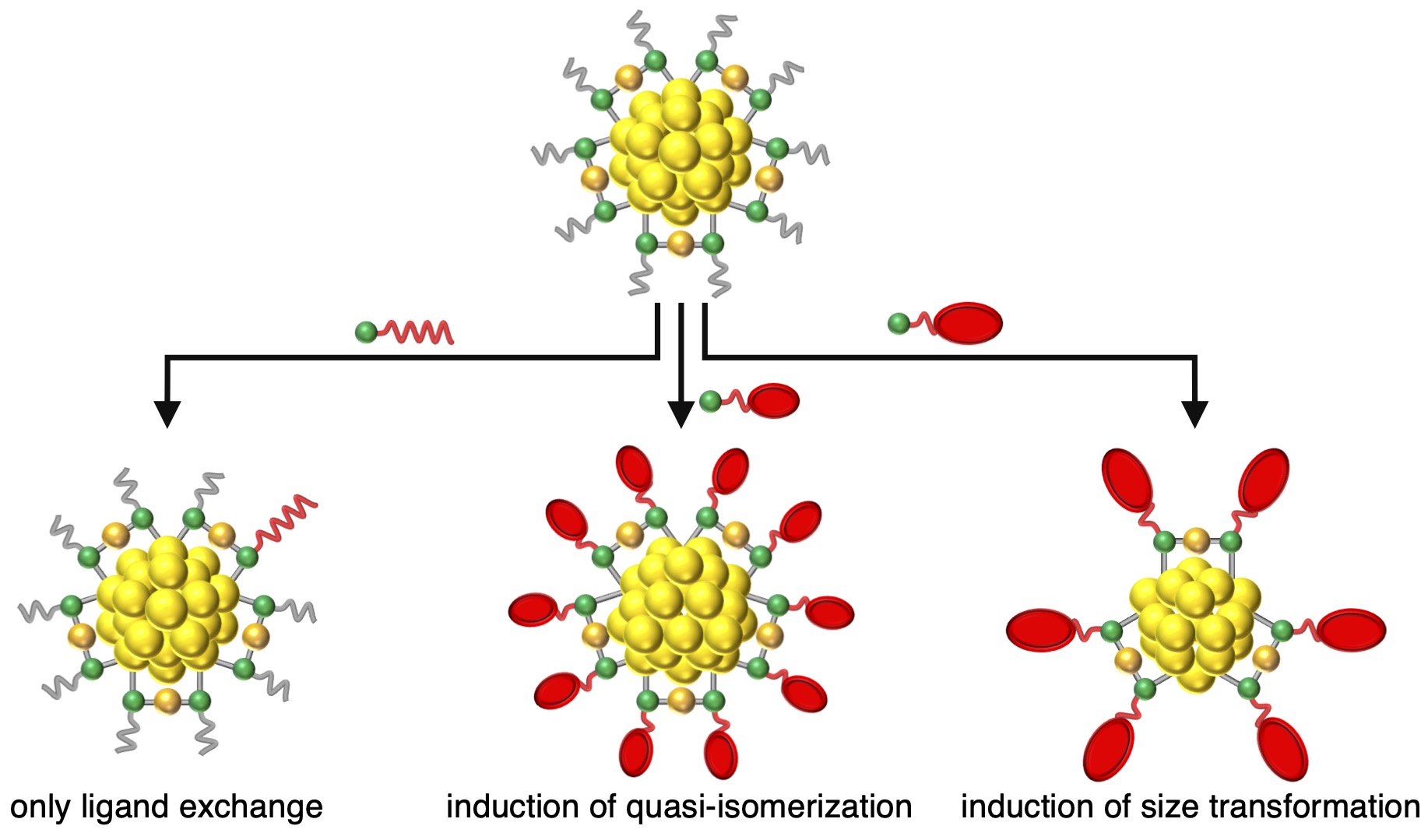
5)"Precise Synthesis, Functionalization and Application of Thiolate-Protected
Gold Clusters"
W. Kurashige, Y. Niihori, S. Sharma, Y. Negishi*
Coord. Chem. Rev., 320-321, 238-250 (2016).
Invited "Review" to "Special Issue"
Thiolate-protected gold clusters (Aun(SR)m) have received significant attention
as new functional nanomaterials because they exhibit size-specific physical
and chemical properties that are not seen in bulk gold. To date, our research
group has studied the following three aspects of Aun(SR)m and related clusters:
(1) the development of new methods allowing precise synthesis; (2) the
establishment of new methods to impart high functionality; and (3) the
utilization of these clusters as active sites in photocatalytic materials.
This review summarizes our most recent work concerning these three subjects.
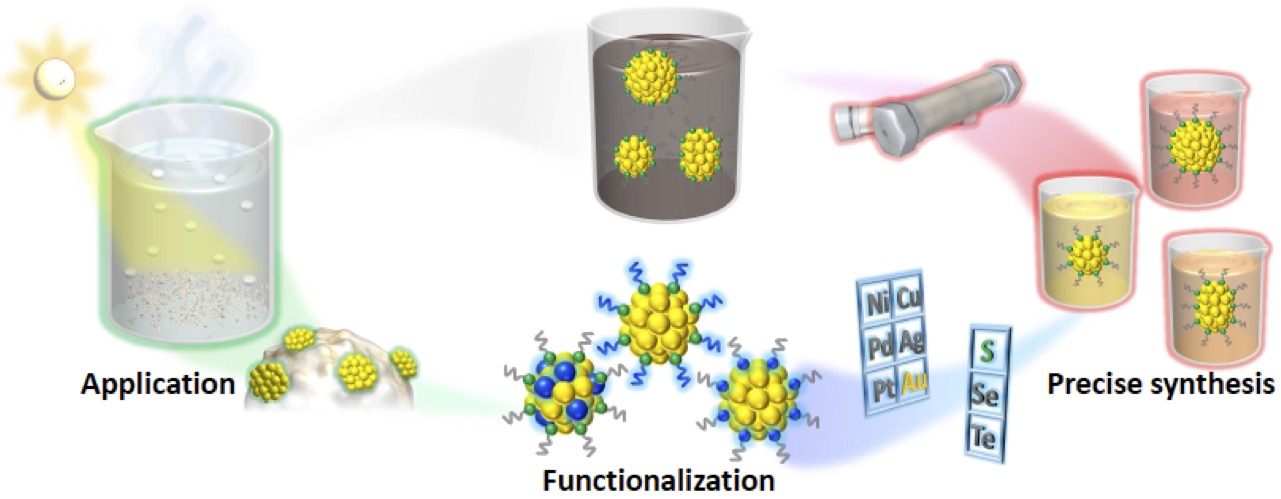
4)"High-Resolution Separation of Thiolate-Protected Gold Clusters
by Reversed-Phase High-Performance Liquid Chromatography"
Y. Niihori, C. Uchida, W. Kurashige, Y. Negishi*
Phys. Chem. Chem. Phys. (Perspective), 18, 4251-4265 (2016).
Invited "Perspective"
Selected as "Outside Front Cover"
Highly Cited Paper
Thiolate (RS)-protected gold clusters (Aun(SR)m) have attracted much attention
as building blocks of functional nanomaterials. Our group has been studying
the high-resolution separation of Aun(SR)m clusters using reversed-phase
high-performance liquid chromatography. In this perspective, we summarize
our recent results on the separation of Aun(SR)m clusters and their doped
clusters according to the core size, charge state, ligand composition,
and coordination isomers. Additionally, this perspective describes new
findings obtained by using high-resolution separation and future prospects
for the separation of such types of metal clusters. We believe that the
techniques and knowledge gained in this study would contribute to the creation
of Aun(SR)m clusters with the desired functions and associated functional
nanomaterials.
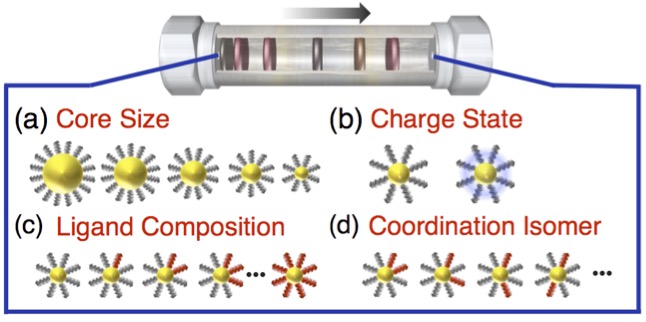
3)"Recent Progress in the Functionalization Methods of Thiolate-Protected
Gold Clusters"
W. Kurashige, Y. Niihori, S. Sharma, Y. Negishi*
J. Phys. Chem. Lett. (Perspective), 5, 4134-4142 (2014).
Invited "Perspective"
Selected as "Outside Front Cover"
Highlighted in "Editorial"
Nanomaterials that exhibit both stability and functionality are currently
considered to hold great promise as components of nanotechnology devices.
Thiolate-protected gold clusters (Aun(SR)m) have long attracted attention
as functional nanomaterials. Magic Aun(SR)m clusters are an especially
stable group of thiolate-protected clusters that have particularly high
potential as functional materials. Although numerous application experiments
have been conducted for magic Aun(SR)m clusters, it is important that functionalization
methods are also established to allow for effective utilization of these
materials. The results of recent research on heteroatom doping and the
use of other chalcogenide ligands strongly suggest that these strategies
are promising as functionalization methods of magic Aun(SR)m clusters.
In this Perspective, we focus on studies relating to three representative
types of magic clusters—Au25(SR)18, Au38(SR)24, and Au144(SR)60—and discuss
the recent progress and future issues.
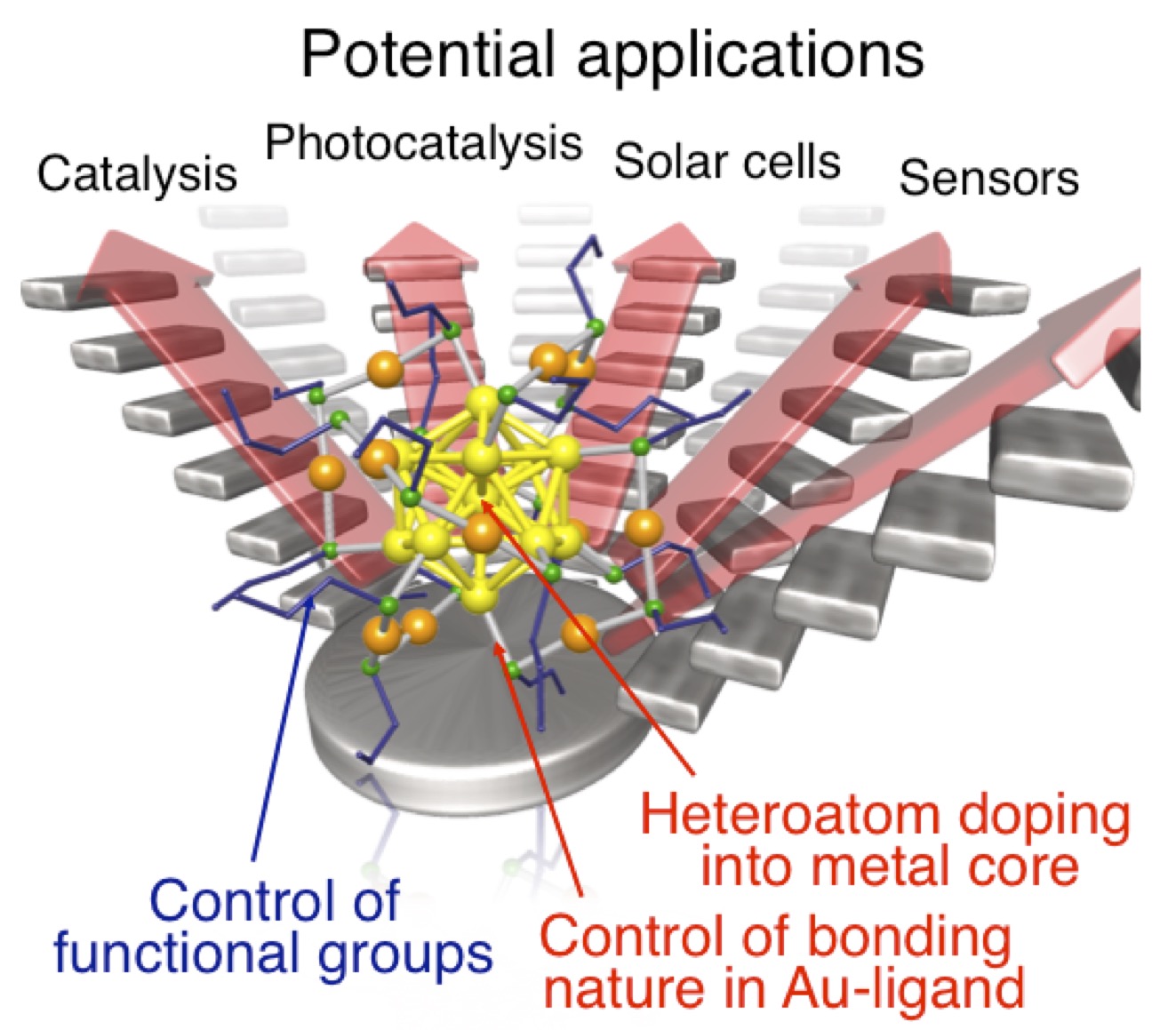
2)"Towards the Creation of Functionalized Metal Nanoclusters and Highly
Active Photocatalytic Materials Using Thiolate-Protected Magic Gold Clusters"
Y. Negishi*
Bull. Chem. Soc. Jpn (Award Accounts), 87, 375-389 (2014).
Invited "Accounts" as "a Winner of CSJ Award for Young Chemists"
Highlighted in "Back Cover"
Advances in developments in nanotechnology have encouraged the creation
of highly functionalized nanomaterials. Thiolate-protected gold clusters
(Aun(SR)m) less than 2 nm in size exhibit size-specific physical and chemical
properties not observed in bulk metals. Therefore, they have attracted
attention as functional units or building blocks in nanotechnology. The
highly stable, magic Aun(SR)m clusters possess great potential as new nanomaterials.
We are studying the following subjects related to magic Aun(SR)m clusters:
(1) establishing methods to enhance their functionality, (2) developing
high-resolution separation methods, and (3) utilizing the clusters as active
sites in photocatalytic materials. Through these studies, we aim to create
highly functional metal nanoclusters and apply them as highly active photocatalytic
materials. The results of our efforts to date are summarized in this paper.

1)"Toward the Creation of Stable, Functionalized Metal Clusters"
Y. Negishi,* W. Kurashige, Y. Niihori, K. Nobusada
Phys. Chem. Chem. Phys. (Perspective), 15, 18736-18751 (2013).
Invited "Perspective"
Selected as "Outside Front Cover"
Selected as "HOT article"
Nanomaterials which exhibit both stability and functionality are currently
considered to hold the most promise as components of nanotechnology devices.
Thiolate (RS)-protected gold nanoclusters (Aun(SR)m) have attracted significant
attention in this regard and, among these, the magic clusters are believed
to be the best candidates since they are the most stable. We have investigated
the effects of heteroatom doping, protection by selenolate ligands and
protection by photoresponsive thiolates on the stability and physical/chemical
properties of these clusters. Through such studies, we have attempted to
establish methods of modifying magic Aun(SR)m clusters as a means of creating
metal clusters that are both robust and functional. This paper summarizes
our studies towards this goal and the obtained results.
